



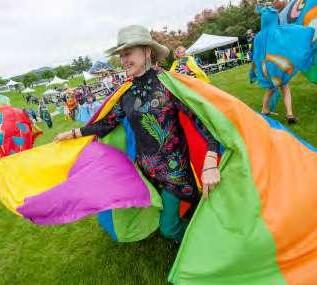





































British Columbia
2020-2025 Cultural Plan Kelowna,

we acknowledge that our community is located on the traditional, ancestral, unceded territory of the syilx/okanagan people.

LEAN A LITTLE CLOSER, STILL BY ERIN SCOTT
Erin Scott is a poet and performer living on Syilx/Okanagan Territory (Kelowna). Her first chapbook, Atrophy, is forthcoming with Kalamalka Press in Spring 2020. Her work has appeared in Ricepaper Magazine, subTerrain Magazine, InspiraTO Festival, and Living Things International Arts Festival.
Imagine a city vibrant with juicy grapes, heavy on green vines that twine around an archway. Underneath this archway is a story of tobacco, a deep and mysterious lake where N’ha-a-itk protects the waters, Arrowleaf Balsam Root springs across the valley hills in orange tufts of sunshine. Bitter root in the dusty soil and the great black bear, there, beside the orchards full of peaches, apples, and cherries.
Lean a little closer in.
Can you hear the singing of local musicians? The drumming of the Okanagan peoples?
Poetry spoken in the streets and the cafes?
Can you see the orchard ladders in the Laurel Museum?
The murals splashed across building sides on St. Paul Street? The bear sculpture, lit and glowing at Stuart Park?
Please, lean a little closer, still.
We have work to do here, under this archway we call home. We have a vision of our culture and the chance to weave a new future with the stories of our past and present. Here, in the Okanagan Valley, we have a call to action.
We are the makers of magic. Each individual in our community can sprout a new tendril to thicken our grape vines, to cultivate the cultural vitality of Kelowna. From the painters and the poets, to the lawyers and accountants, to the Mayor and the City Council, to the settlers and the syilx/Okanagan People. Our story is weaved through our diversity. With each goal we commit to upholding and working on together to achieve, we watch a new bud on our entwined vine unfurl.
Come just a little closer, now. We are almost there.
Let’s commit together. Let us open doors for new spaces. Let us animate our community with tangible vitality. Let us increase our capacity with new opportunities. Let’s deepen our connections to the land, to the people, to the culture of Kelowna. But let’s remember, we are stronger together.
We are not only the grapes at the end of the branch. We are the entire plant. We are the roots upholding the vision. We are the trailing vine that guides and shapes our principles. We are the leaves that protect our goals as we persevere through ups and downs.
And underneath all of it, at the end of the growing season, we are the accumulation of all these things. We are the diverse, malleable and oh so delicious grapes. We are the culture, thickening around the archway, making history in Kelowna.


Page setting the stage executive summary 6 what is culture? 7 about kelowna 8 getting started 9 aligning with imagine kelowna & the ocp 10 why have a cultural plan? 11 culture as an economic driver 12 weaving our collective threads 15 the cultural plan process 16 the main attraction structure of the cultural plan 18 Vision & Guiding Principles 19 Key Themes, Goals & Strategies 20 strategic investments 22 Goal 1: Increase contribution of resources 23 Goal 2: Understand our impact 28 spaces 34 Goal 3: Optimize existing spaces 35 Goal 4: Commit to developing new facilities 40 cultural plan at-a-glance 46 vitality 48 Goal 5: Learn from our past 49 Goal 6: Boost vitality at the street level 54 capacity 60 Goal 7: Support a viable creative sector 61 connections 66 Goal 8: Share our story 67 Goal 9: Broaden the reach 72 Goal 10: Convene and connect 79 behind the scenes (appendix) advisory group 84 methodology for engagement 85 sample community initiatives summary 95 table of contents 5 2020-2025 Cultural Plan
The City’s first Cultural Plan was launched in 2012. Since then, significant progress has been made in implementing various Cultural Plan goals and strategies. Many already-existing cultural organizations have thrived, while new organizations and venues have emerged. Cultural spaces are heavily used, many at or near capacity. The Cultural District has been positively impacted by major initiatives such as the Bernard Avenue revitalization, the Civic Precinct Block Plan, relocation of the RCMP detachment, completion of new parkades and the opening of Kelowna's Innovation Centre.
Today, our community demographics are skewing younger. The unaffordability of spaces for living, working and creating is a challenge for many artists. In addition, key buildings in the City’s inventory of cultural infrastructure such as the Kelowna Community Theatre and the Okanagan Heritage Museum, continue to age with mounting structural deficits, while new buildings go up around them. This updated Cultural Plan is intended to respond to these changes and challenges and set a direction for the future.
The process to update the Cultural Plan for 2020-2025 began in July 2018. While this 15-month project was led by the Cultural Services Department, the final plan was the work of many arts, culture and heritage organizations, collectives, artists, key stakeholders, Council, city staff and members of the public. The community was involved through surveys, online discussion forums, host your own engagement events, interviews, workshops and open houses.

The pieces of this plan all build on one another and each piece answers a critical question:
1. Vision – if we are successful in the implementation of the plan what would we hope to see?
2. Guiding Principles – to reach the vision what principles are integral to each key theme, goal, strategy and community initiative?
3. Key Themes & Goals – what are the key areas that we need to focus on to achieve the vision?
4. Strategies – what will we specifically focus our efforts and investments on over the next six years?
5. Community Initiatives – what can governments, organizations, businesses, capacity builders, funders, artists and residents do to help advance the strategies? Examples of community initiatives are identified to spark ideas about what else can be done to support the plan and vision.
This plan sets priorities for the enhancement of cultural vitality and community spaces and aligns with the Imagine Kelowna goal of an engaging arts and culture scene. This plan strives for a balance between being too vague in its priorities, therefore accomplishing little, and being too prescriptive, which would limit the ability to take advantage of new opportunities that may arise.
Most importantly, this plan sets a course for the entire creative sector to provide accessible, diverse and inclusive experiences, that uses resources effectively, leverages opportunities, is innovative and forward thinking and highlights the value of partnerships and cooperation.
2020-2025 Cultural Plan 6 executive summary
the next phase of cultural development in kelowna will bring about new programs, relationships, commitments and support. everyone has a role to play.
what is culture?
At the beginning of the Cultural Plan engagement process, community members were asked to define culture. A total of 171 different definitions were submitted, many with common themes, and all with unique perspectives. Additional sampling of various definitions contributed by community members are sprinkled throughout this document.
Members of our community describe culture as:
• Place, history and shared experience formed and expressed through the creative arts and community activities. As culture emerges and develops, it generates a unique identity that impacts the lives of residents, visitors and tourists.

• Expressions of traditions and talents from diverse groups that create the heartbeat of our community. Culture enriches lives through knowledge sharing, empathy and adds vibrancy to everyday life.
• Our habits, rituals, performances and actions that give us meaning. The physical aspects of our environment that give us a sense of place. How we interact with each other and our space.
• Something that expands your world view and perspectives, draws on heritage, backgrounds, arts and experiences to create a wider understanding of the world around.
• The soul of a city.
It may not be possible to arrive at a precise definition of the word “culture.” As noted in the 2012-2017 Cultural Plan, culture can mean different things to different people. The 2020-2025 Cultural Plan takes a similar approach and defines culture as:
7
a porous and flexible concept which includes heritage, the arts, human diversity and many other attributes and practices. throughout this plan, use of the word ‘culture’ is intended to be broadly inclusive.
about kelowna

Kelowna is in the heart of the Okanagan on the traditional territory of the syilx/Okanagan People. Nestled in the Okanagan Valley, Kelowna is bordered by mountains, lush agricultural land and orchards, as well as the stunning Okanagan Lake. Kelowna is the third largest city in British Columbia and one of the fastest growing cities in Canada. It is currently home to just over 131,000 residents. Kelowna enjoys four distinct seasons and each has its own unique appeal. Tourists flock to the city’s beaches and patios in the summer to soak up the sunshine and enjoy the lake life. The fall is a photographer’s dream with vibrant maple leaves lining the city’s hiking and walking trails. Snowy mountain peaks are perfect for skiing and snowboarding in the winter, while the spring boasts perfect weather for golf and touring the region’s numerous wineries.
Kelowna has a rich history, beginning over 6,000 years ago with the settlement of the syilx/Okanagan People. Kelowna, which means ‘Grizzly Bear’ in the nsyilxc n language, became a city in 1905 when the population was only 600 people. While culture is enjoyed throughout the city, it is on full display in the city’s downtown Cultural District. Once the centre of the Okanagan’s fruit packing industry, the six-block area has become a hub of Kelowna’s artistic and cultural activities.
2020-2025 Cultural Plan 8
e
getting started
Cultural development at the City of Kelowna began in the early 1970’s when a committee formed to study the possibility of developing a Cultural Arts Centre.
In 1989, the City established a Mayor’s task force to create a cultural policy to give form, support and provide direction for cultural development in Kelowna. Since then, significant progress has been made to integrate arts and culture into overall community planning and delivery of services to residents and visitors.

Today, Cultural Policy #274 provides a commitment and direction for cultural development. This policy states that:
The City will develop and regularly update a Cultural Plan to guide civic cultural initiatives.
The process for the Cultural Plan will include:
• Information gathering from, and consultations with, local stakeholders and the community-at-large. This may take the form of surveys, workshops and/or Open Houses;
• Review of best practices and comparable plans from other jurisdictions;
• Preparation and submission of a document which will establish an overall vision, goals, specific strategies and an implementation plan.
The Cultural Plan will require on-going implementation, monitoring and review.
2020-2025 Cultural Plan 9
kelowna has come a long way when it comes to cultural development, but there is still a long way to go. this plan provides direction on how to accomplish the cultural future that our community envisions.
aligning with the official community plan and imagine kelowna
The Official Community Plan (OCP) is the primary tool that local governments use to guide the long-term growth of their communities. In Kelowna, the OCP sets out the vision, strategies and objectives for 20 years of growth.
The OCP knits together policies covering a wide range of areas into a growth strategy that sets the city on a path towards its desired long-term vision. Some areas include public art, cultural and heritage facilities and spaces, neighbourhoods and landscapes.
As a high-level, long-term policy document, the OCP is a powerful growth management tool that is grounded in the community’s vision for the future.
The Imagine Kelowna community vision summarizes what residents want our city to look like by 2040. It envisions a community that puts people first, values its history, encourages curiosity and creativity and recognizes the changing roles of individuals, businesses, governments and community organizations. Imagine Kelowna has four principles (connected, smarter, responsible, collaborative) and 14 goals.
the result of almost 4,000 resident contributions, imagine kelowna is a vision created by our community, for our community.
The vision and principles are higher-level, while the goals articulate more specific policy direction.
2020-2025 Cultural Plan 10
How do all the City’s plans work together? Community Master plans and strategies Imagine Kelowna: vision into action Divisional and departmental plans Annual action plan Annual budgeting & delivery (operations) Strategic direction Where do we get our direction from? Strategic delivery How do we deliver the direction over the long term? Action plans What actions need to be taken in the next 1 – 4 yrs? Resources How do we fund and execute? Corporate Council ◥ Multiple stakeholders provide input, much is captured in the Imagine Kelowna community vision. ◥ Examples: Official Community Plan; Capital Plans; Financial Plans; Servicing Strategies ◥ Council & Corporate results to focus on during Council’s term. ◥ Each division and department considers how to align to the direction and what’s needed to execute for success. ◥ Money & people are needed to implement our plans and deliver our day to day programs & services. Council priorities: 2019-2022
an ecosystem of plans
why have a cultural plan?
“Planning is critical to success in every facet of our lives. Cultural planning offers an opportunity for communities to create a roadmap unique to their needs, aspirations and strengths. By planning strategically, local governments and arts groups can work together to integrate arts and culture more fully into their community.”
Honourable Stan Hagen, Minister of Tourism, Sport and the Arts Cultural Planning Toolkit (2010), Creative Cities Network
culture is...
a community asset
Cultural planning is a way of viewing all aspects of a community’s cultural life as a community asset. It considers the increased and diverse benefits these assets bring to the community both now and in the future. Understanding culture and cultural activities as resources for community development, rather than merely as cultural “products” to be subsidized, unlocks possibilities of enormous value.
a different way to look at our community
The 2020-2025 Cultural Plan is a way to look at our community’s strengths, issues and concerns. The plan provides a refreshed perspective and action-oriented strategies that will help find ways to support:
• community involvement and ownership of local cultural initiatives
• democratic cultural policy by better understanding what people are doing and want to do
• the development of meaningful and respectful relationships
• more programs and services in response to the desires of the community
• communication and cooperation among the creative sector and other community groups
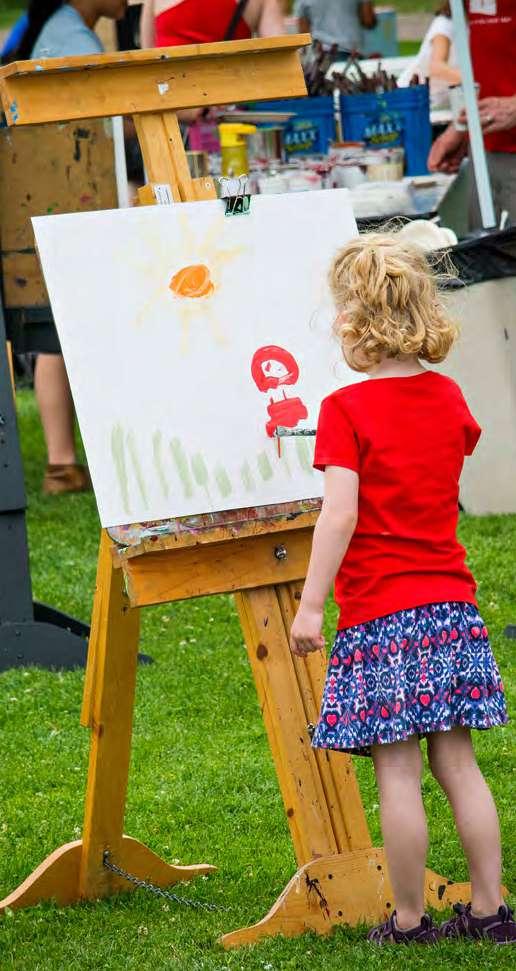
• the effective integration of culture into the larger community
• a greater awareness and understanding of the cultural sector’s potential economic impact
• the visibility of community artists, cultural workers and organizations
• the improvement of community safety and combatting social exclusion for everyone
• access to cultural activities and the development of larger audiences
• cultural facility development
• increased public and private support for culture
In recognizing that culture delivers much more than just material and economic rewards, the 2020-2025 Cultural Plan sets a direction for cultural development in Kelowna.
2020-2025 Cultural Plan 11
much more than just something that is good for the economy, but it’s that too!
culture as an economic driver
The Kelowna Creative Sector Economic Impact Assessment report was prepared as part of the 2020-2025 Cultural Plan development by Jamie Vann Struth of Vann Struth Consulting Group Inc. The report provides an updated estimate of the creative sector’s economic impact in Kelowna, which was previously studied in 2010. The report helps identify the creative sector’s progress since the adoption of the 2012-2017 Cultural Plan and informs the strategies for continued development of the sector through 2025.
The report divides the creative sector into 11 components. Each component is analyzed using statistics, results of a confidential online survey and other public data to generate employment, revenue and income estimates. The results are impressive.
The full report calculates the economic spinoffs generated by suppliers to the creative sector (called indirect impact) and the household spending of affected workers (called induced impact). The report also looks at the self-employment rate among artists, the impressive level of volunteerism within the creative sector and how the creative sector overlaps and supports the city’s tourism sector.

It is important to note that an economic impact analysis is largely based on market-oriented metrics such as revenue, income and paid employment. This framework can be an awkward fit with the creative sector, which includes many participants who are not regularly paid and who participate in creative activities because of their passion for the arts and the intrinsic value it provides them personally, as well as to their audiences and the community at large. These values are not easily measured in a standard economic impact assessment, even if they are among the most important ways that the creative sector provides value to the community.
2020-2025 Cultural Plan
12
economic impact assessment




Summary of findings from the from the Kelowna Creative Sector Economic Impact Assessment. A copy of the full report is available at kelowna.ca/culture.

13 2020-2025 Cultural Plan
626
342
1,279 3,168
The syilx/Okanagan nation must have full and direct involvement throughout a cultural planning framework constructed through a lens of real partnership, reconciliation, and common understanding.
- Weaving Our Collective Threads: Offering a Pathway for Syilx Creativity Within the City of Kelowna

weaving our collective threads
offering a pathway for syilx creativity within the city of kelowna
Kelowna’s creative sector, along with the City of Kelowna, acknowledges that working with syilx/Okanagan governments, communities, artists and community members is an ongoing process. It is a process that requires a long-term commitment to relationship building and reconciliation efforts. It requires a change in thinking and a reconsideration of existing frameworks and processes. As such, the process of working with our Indigenous hosts is intentionally organic, flexible and intended to develop over time. It is by continuing this journey together that we will make the greatest progress toward intentional and meaningful change.
Excerpt from the report: Weaving our Collective Threads: Offering a Pathway for Syilx Creativity Within the City of Kelowna by Carrie Terbasket, Stands Above Consulting (2019).
For syilx people, culture is not separate from the natural world, but rather one living and breathing entity The methods of our survival have depended on our relationship with the natural world and expressing those relationships and resulting responsibilities through our creativity. The way that syilx people view arts, culture, and heritage is very different from the western perspective. The creative sector of Kelowna, through its Cultural Planning process, must make space for the voice and presence of the syilx peoplethe rightful caretakers of the lands and waters in which Kelowna is situated. The underlying and all-encompassing spirit that makes Kelowna such a beautiful place to live, work, play, and be, is the very same spirit that has sustained the syilx People since time out of mind.
The city of Kelowna has an opportunity to be innovative and cutting edge in its approach to cultural planning. It is essential that respectful and reciprocal relationships are built between the creative sector of Kelowna and the syilx/Okanagan Nation that acknowledges the leadership and responsibility of the syilx People. In addition, the City of Kelowna has a duty to respond to the current gap it has in relation to understanding and acknowledging the space required for syilx expression that are being forgotten in this context. True innovation will require the creative sector of Kelowna to think outside the box for something meaningful that develops a new set of principles and commitments to syilx People.
If the primary goal of this new Cultural Plan is to nurture and promote cultural values in the city of Kelowna, then maybe a fundamental similarity exists which can provide a space of commonality to create a new approach to a higher, more restored level of Cultural Planning. Essential to this new approach is the meaningful contribution of syilx People in the creation and implementation of a new Cultural Plan. Specifically, leadership by syilx governments, communities, and organizations are key to the successful development of the City of Kelowna’s new Cultural Plan. Supporting the syilx Peoples to share the driver’s seat on cultural planning would constitute a step toward reconciliation, and importantly, reconciliation that is well outside of the status quo.
Through this new framework, the syilx Nation will not simply be responding to already crafted goals and strategies with little to no capacity to do so. As seen in many other municipalities, this after-the-fact approach does not work. Shared experiences will lead to greater understanding, appreciation, and support of the necessary and profound ways in which syilx People express and share their culture and creativity.
The idea of creating a plan for the creative sector of Kelowna that enhances and honours human creative expression has deep commonality with the syilx perspective and world view on what constitutes a healthy life – or, as we say - living the good syilx life. The City of Kelowna, on its journey of updating its Cultural Plan, should consider and centralize a way in which this new plan contains the space, support, and language that will open the door for syilx people to feel welcome to take their rightful places as hosts of this beautiful city located in the heart of unceded syilx lands and waters. Our world needs a more open and secure place – we all deserve to be free to express ourselves and celebrate our unique cultures and ways of being in this world Artists will lead us all to that freedom. However, we have to take care of our collective hurt first, we have to be brave enough to have the conversations and develop understandings that will open the space for our vision to be fully realized The built environment that makes up the city of Kelowna remains a sacred and valued space within syilx territory. As the largest urban centre within syilx lands and waters, Kelowna holds a unique responsibility and opportunity to become a leading centre of excellence for arts and culture.
This report was prepared for the City of Kelowna as a component of the Cultural Plan engagement process. This report does not, and cannot be used to, speak for any First Nation in any capacity A copy of the full report is available at kelowna.ca/culture.
15 2020-2025 Cultural Plan 15
the cultural plan process
cultural plan timeline
Over a 15-month process (July 2018 - September 2019), the development of the 2020-2025 Cultural Plan moved through three phases and each phase had two or three components:

• Discover Phase – Framing, Engagement, Synthesis
• Design Phase – Shaping the vision, Mobilizing commitment, Adopting the plan
• Deliver Phase – Launching the plan, Moving forward
supplemental reports
In addition to the 2020-2025 Cultural Plan, five complementary reports were prepared to enhance key focus areas of the Plan’s development:
• 2012-2017 Cultural Report Card
• Kelowna Creative Sector Economic Impact Assessment
• Weaving Our Collective Threads: Offering a Pathway for Syilx Creativity Within the City of Kelowna
• Capstone Project: Data Analysis Report Summary
• Cultural Facilities Master Plan (this report is scheduled to be release in late fall 2019)
These additional reports include a variety of qualitative and quantitative data collected from a wide range of sources. The reports are available online at kelowna.ca/culture.
2020-2025 Cultural Plan
16
consulting with the community - overview of engagement opportunities
The development of the Cultural Plan required a deep understanding and appreciation of the population which it is intended to serve. That is why significant time and effort was put into ensuring a variety of methods were used to solicit feedback from interested stakeholders.
Activities included:
• online and paper surveys
• online discussion forums
• children’s “Cultural Footprint” activity
• “Host Your Own Engagement” events and grant program
• Young Professionals Open House
• Youth and Young Professionals Forum
• Innovation Centre Chalk Wall
• multiple stakeholder workshops and open house events

• stakeholder interviews
A more detailed description about the above engagement activities are contained in Appendix II: Methodology for Engagement
cultural plan advisory group
The Cultural Plan Advisory Group supported the Cultural Services Department by providing perspective and input into the plan’s creation. The Advisory Group is made up of 19 members comprised of two sub-groups including:
1. Internal Advisory Group: included nine staff members from the City of Kelowna, appointed because their area of responsibility is impacted or directly impacts the advancement of the plan’s goals and strategies within the City of Kelowna.
2. External Advisory Group: included 10 members of the arts, culture and heritage community with broad representation of artistic disciplines and practices, including strong representation from individual practitioners. These members volunteered their time.
Biographies for all external members of the Advisory Group are provided in the appendix.
The Advisory Group met six times over the 15-month period in a workshop setting. Topics for each workshop varied and allowed members to work through information received from the community in a systematic way. The Advisory Group provided feedback on key aspects of the plan.
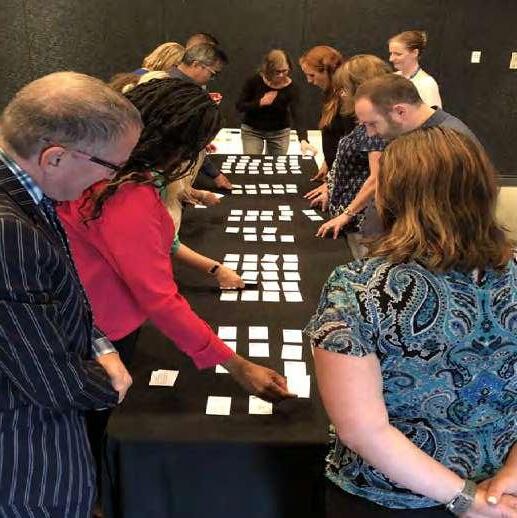
cultural planning toolkit
This plan was developed using the Cultural Planning Toolkit, which was created through a partnership between 2010 Legacies
Now and Creative City Network of Canada. The toolkit can be found at creativecity.ca.
2020-2025 Cultural Plan 17
structure of the 2020-2025 cultural plan
vision
4 guiding principles
5 key themes 10 goals
50 strategies sample community initiatives
the pieces of this plan all build on one another and each piece answers a critical question:
Vision: if we are successful in the implementation of the plan what would we hope to see?
Guiding Principles: to reach the vision what principles are integral to each key theme, goal, strategy and community initiative?
Key Themes & Goals: what are the key areas that we need to focus on to achieve the vision?
Strategies: what will we specifically focus our efforts and investments on over the next six years?
Community Initiatives: what can governments, organizations, businesses, capacity builders, funders, artists and residents do to help advance the strategies? Examples of sample community initiatives are identified to spark ideas about what else can be done to support the plan and vision.
The inclusion of sample community initiatives at the base of this triangle highlights how critically important it is that everyone supports the plan’s strategies, goals, themes and principles. Without that support, it will be impossible to achieve the vision.
18
2020-2025 Cultural Plan
The 2020-2025 Cultural Plan includes a vision, four guiding principles, five key themes, 10 goals, 50 strategies and numerous sample community initiatives.
vision
We see a community which...
embraces and celebrates diversity and is open and welcoming to all
is recognized as a four-season destination with a rich variety of high-quality arts, culture and heritage experiences
fosters innovation, attracts and retains people in its workforce

has distinct urban centres that understand their histories and promote their uniqueness while encouraging flow between each one
is a leader in building collaborations and increasing quality of life for future generations
invests in infrastructure, artists and non-profit organizations as a way to build character and identity

guiding principles
accessibility, diversity & inclusion
proactively welcomes and encourages the discovery of new experiences and art forms
has meaningful and ongoing consultation with our First Nation hosts and provides new opportunities for Indigenous voice and expression
showcases its histories through its people, activities, buildings, landscapes, sites and stories
tackles challenges critically and creatively with an open spirit
We welcome everyone to engage in quality experiences that showcase the unique identity of our community. This principle acknowledges that syilx perspective and worldview is not the same as western concepts and methods of cultural planning and that fair and equitable support is necessary
accountability & fiscal responsibility
We use resources effectively to leverage opportunities that optimize value and create impact. This principle acknowledges that partnerships with syilx organizations and/ or governments are co-created . In all instances where feedback is sought, the circle of sharing must be closed and there is a responsibility to report back about how the feedback was applied.
innovation

We support forward-thinking solutions that anticipate needs and brings together a range of experiences to see the future in a different way. This principle acknowledges that a commitment to truth-telling and shining a light on inequities to envision a bold new future for arts and culture is necessary. All partners must be willing to explore and experiment.
partnerships & cooperation

We achieve more through meaningful relationships of mutual respect and understanding. This principle acknowledges that meaningful partnerships with syilx governments, organizations and people is important and that existing power structures and dynamics need to be examined .

2020-2025 Cultural Plan 19
structure of the 2020-2025 cultural plan
key themes
strategic investments
foster deliberate investments of time, money and people into demonstrated outcomes
spaces
use new and traditional approaches for enhancing the availability, affordability and accessibility of spaces for culture
vitality
animate the community with a blend of programs, services and events that promote artistic excellence and share Kelowna’s history

capacity
build on the creative sector’s ability to respond to changing demands and new opportunities
connections
promote ongoing interactions between people, sectors and disciplines
SPACES
VITALITY
STRATEGIC INVESTMENTS
CONNECTIONS CAPACITY
Strategic investments is in the center of the diagram to demonstrate its importance across all the key theme areas. Investment in the creative sector will be instrumental in our success and threads through the remaining four areas.
2020-2025 Cultural Plan 20
What is Culture?
“All that makes and defines us as 'human' - how we communicate, celebrate, share, traditions, values, beliefs, arts, language, stories, architecture, music and dance."

2020-2025 Cultural Plan 21
strategic investments
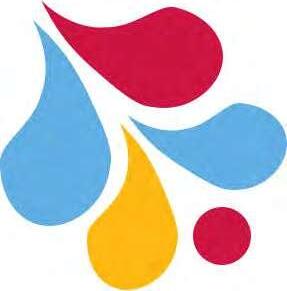
Foster deliberate investments of time, money and people into demonstrated outcomes
Increased investment in the creative sector will be instrumental to this plan’s success and is important to all the key theme areas. While increased funding is critical to artists and organizations, this theme is also about investments of time and people. For example, an event’s success is dependent on generating enough revenue to support its operations as well as on volunteers investing their time and skills. This is also true for cultural organizations. They require funding to operate but also need skilled people on their boards of directors to provide guidance on topics like governance, finance, human resources and risk management.
Strategic investments require us to think ahead and identify the long-term goals and strategies needed to achieve them. Strategic investment is a longterm strategy, not a band-aid solution to a problem. The creative sector requires carefully designed and planned investments to ensure they meet the needs of the community.
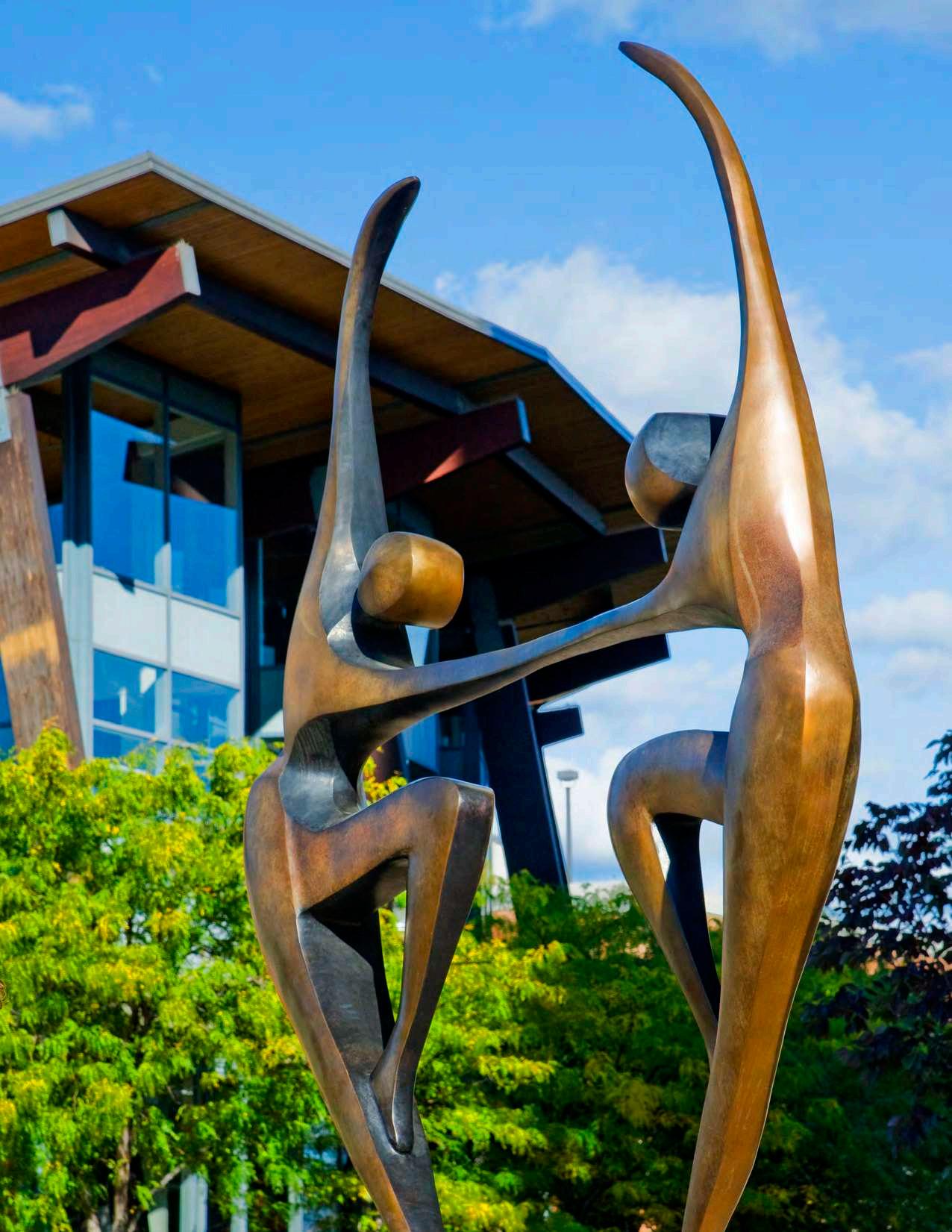
goal 1 : increase contribution of resources
Develop a variety of approaches to increase support for the creative sector’s spaces, capacity, vitality and connections.

In 2018, the City of Kelowna invested approximately $3 million into the creative sector. Support was provided in the form of: Cultural Services administration; operation of the Kelowna Community Theatre; annual operating support for Kelowna Art Gallery, Rotary Centre for the Arts and Kelowna Museums; the professional arts program; Festivals Kelowna funding; general operating grants; project grants; organization development grants; heritage building grants; support to the Sister City program; permissive tax exemptions; and the public art program. All of this support adds up to a per-capita investment of $23.59 by the City.
Investment by the City is only part of the story, however. Organizations can leverage the City’s support by engaging with other levels of government and the private sector, along with their own earned revenue. In 2018, non-profit organizations funded under the Professional Arts program were able to leverage an additional $19.92 for every dollar invested by the City.
Support and expertise are also provided to the creative sector through volunteerism. In 2018, an estimated 380,000 volunteer hours were contributed to Kelowna’s creative sector (VannStruth, 2019. Kelowna Creative Sector Economic Impact Assessment). Every year, volunteers provide organizations in the sector with valuable skills and labour worth millions of dollars, enhancing their programs and events.
The value of culture far outweighs the per-capita costs and the City has a vital and on-going role in providing support to the creative sector. However, the responsibility must be shared with all levels of government, the private sector and the community.
how will we know if we are successful?
The evaluation criteria provided below is the starting point for evaluating this plan’s successful implementation. These criteria however, are not exclusive. Every community initiative that aligns with this plan will have its own way of measuring success. In addition, qualitative measures of success can be undervalued when there is a focus on quantitative measures.
evaluation criteria:
• Total dollars invested by the City of Kelowna to cultural organizations
• Municipal contributions leveraged by other public and private sector contributions
• Number of volunteer hours provided to funded organizations (hours, $ value, full-time equivalents)
• Number of unique volunteers

• Average income of creative sector workers
• Total dollars invested in cultural infrastructure projects (public and private)
2020-2025 Cultural Plan 23
strategic investments: increase contribution of resources
strategy 1.1 increase funding to local organizations with a focus on multi-year and core operating funding
Initiatives that support this strategy will increase overall financial support received by organizations. Emphasis in this area will be on initiatives that support more sustainable funding sources.
How could this be achieved?
Actively search and apply for new funding opportunities
Develop culture specific funding opportunities


artists & cultural organizations funders, business sector & capacity builders


Change current Cultural Grant Program to include multi-year funding & additional general operating support
city of kelowna & other levels of government
Select a local cultural organization to support when choosing to donate to charities
audience members & general public
how will you support this strategy?
strategy 1.2 inform community members about opportunities to become involved with cultural organizations



Initiatives that support this strategy will clarify the volunteer needs of the creative sector, improve the sector’s ability to communicate those needs and support volunteers working within organizations.
How could this be achieved?
Clarify volunteer positions and promote opportunities to the community

artists & cultural organizations
Promote volunteer opportunities in the creative sector through the Arts and Culture e-newsletter
city of kelowna & other levels of government
Implement a volunteer program within the workplace


funders, business sector & capacity builders
Find a local cultural organization to give 1-2 hours per week as a board member or program volunteer
audience members & general public
how will you support this strategy?
2020-2025 Cultural Plan 24
strategy 1.3 promote fair wages for arts professionals and support strategies aimed at attracting skilled creative workers and enterprises to kelowna
Initiatives that support this strategy will promote an understanding of fair wages, encourage appropriate compensation for those working in the creative sector and create an environment that attracts artists to live and work in Kelowna.
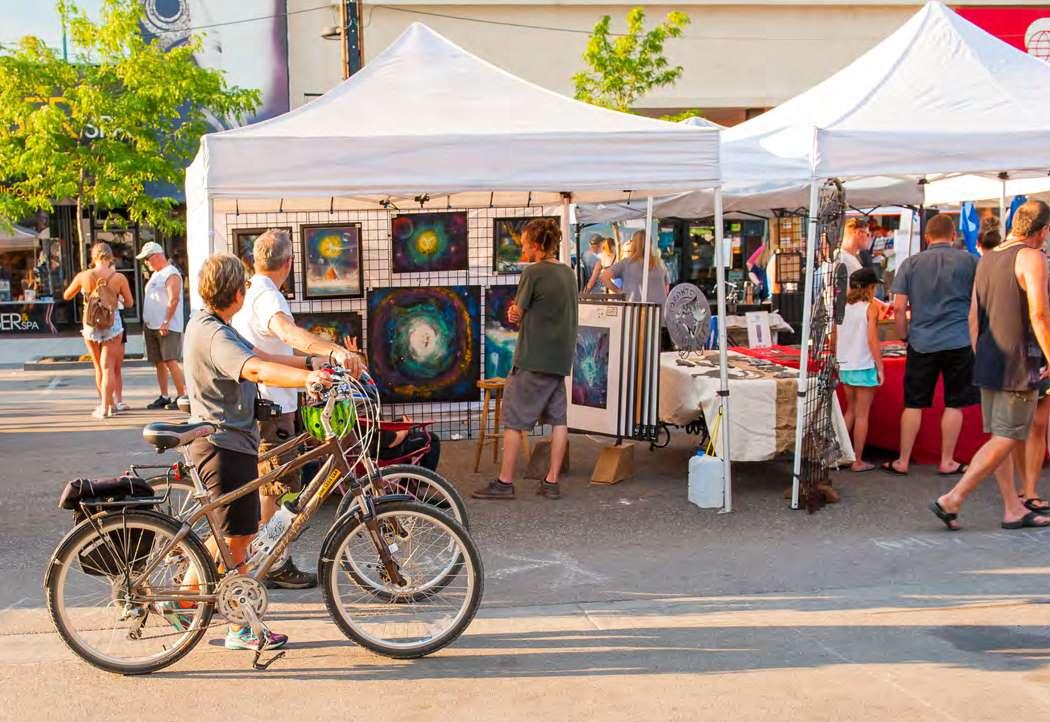
How could this be achieved?
Review current practices for compensating arts professionals and make any necessary adjustments

artists & cultural organizations
Ensure organizations that receive government funding compensate artists appropriately
Demand that artists are paid fairly for their work at events supported by your company
funders, business sector & capacity builders




Make the next book you purchase and read from a local author
audience members & general public city of kelowna & other levels of government
how will you support this strategy?
2020-2025 Cultural Plan 25
strategic investments: increase contribution of resources
strategy 1.4 develop funding that strengthens relationships and fosters a more inclusive community that is respectful to all cultures
Initiatives that support this strategy will offer support for relationship building with cultural groups, fund initiatives that encourage sharing and celebrating diversity and educate residents on the abundance of cultures that build our community
How could this be achieved?
Modify current programs or internal systems to better support relationship building with multicultural organizations




Work collectively as funders to develop a program that supports the sharing of multiculturalism with the broader community
artists & cultural organizations funders, business sector & capacity builders


Amend the current Cultural Grant Program to prioritize funding support for projects that promote greater diversity and relationship building
city of kelowna & other levels of government
Commit to learning and understanding more about the diverse cultural groups that make up Kelowna
audience members & general public
how will you support this strategy?
strategy 1.5 invest in cultural infrastructure


Initiatives that support this strategy will contribute to the development of new cultural infrastructure or the redevelopment of already-existing cultural infrastructure through relationship building and the investment of time, skills and other needed resources.
How could this be achieved?
Document your needs and be ready for opportunities that may arise to support infrastructure development
artists & cultural organizations
Partner with public funders and non-profit organizations to invest money in the development of long-term capital projects
funders, business sector & capacity builders


Include new cultural facilities and infrastructure regeneration in the capital plan
audience members & general public city of kelowna & other levels of government
how will you support this strategy?
Volunteer your carpentry, painting or other technical skills to support renewal of facilities 2020-2025
26
Plan
Cultural
What is Culture?

2020-2025 Cultural Plan 27
"Culture covers a broad range of interests and activities that enrich our lives and our understanding of others."
goal 2 : understand our impact
Culture has a major impact on our lives and our economy. However, in order to maximize the ability to leverage private and public sector support for culture, we first need to deepen the level of understanding about the impact of cultural programs and services on our community. This information is a vital component of internal planning and evaluation. While cultural programs and events have a strong connection to the economic vibrancy of our community (see Culture as an Economic Driver), culture provides much more than just economic benefits. Additional qualitative and quantitative data are needed to accurately illustrate the impact culture has on the health, creativity and innovation of our residents. For example:
Engagement with arts and culture in a variety of different activities has consistently been found to improve self-reported levels of physical and mental health. When comparing people who participate in cultural activities against those who don’t, 57 per cent of participants reported their health as “very good” or “excellent”, compared to 48 per cent of non-participants. Meanwhile, 65 per cent of participants reported their mental health as “very good” or “excellent”, compared to 50 per cent of non-participants. (Hill Strategies, 2013. The Arts and Individual Well-Being in Canada)
Creative engagement can decrease anxiety, stress and mood disturbances, all of which have links to chronic health issues. (Stuckey, H. L., & Nobel, J., 2010. The connection between art, healing, and public health: a review of current literature)
In mothers with moderate-severe Post Natal Depression, singing therapy showed to significantly reduce their symptoms, and to do so faster than other forms of treatment such as creative play therapy. (Fancourt, D., & Perkins, R., 2018. Effect of singing interventions on symptoms of postnatal depression)
how will we know if we are successful?
The evaluation criteria provided below is the starting point for evaluating this plan’s successful implementation. These criteria however, are not exclusive. Every community initiative that aligns with this plan will have its own way of measuring success. In addition, qualitative measures of success can be undervalued when there is a focus on quantitative measures.
evaluation criteria:
• Development of a standardized approach to measuring impacts and sharing results
• Direct, indirect and induced economic impacts of the creative sector
• Gross domestic product (GDP) of the creative sector
• Total dollars earned for every dollar invested by the private and public sector (leverage)
• Number of establishments (organizations, artists, businesses, etc.) operating in Kelowna’s creative sector
• Employment by full-time equivalent positions
• Creative sector impact on tourism
• Stories from participants about how participation impacted them
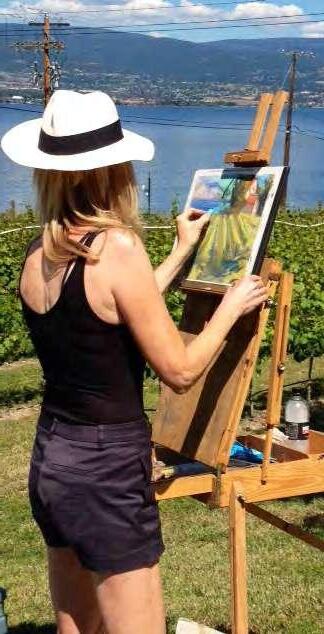
2020-2025 Cultural Plan 28
Leverage the value that culture contributes to the community.
strategy 2.1 use a coordinated approach to measure the impact of the creative sector on the community that includes looking beyond economic multipliers
Initiatives that support this strategy will develop tools or frameworks that support the collection of data on the impact of the creative sector on the community beyond just economics. This strategy is further developed in Strategy 2.2 and 2.4.
How could this be achieved?
Determine a set of measurable criteria that demonstrates the creative sector’s impact
artists & cultural organizations


Implement an online grant application and reporting program that allows for automated data collection

Develop an innovative technology solution that can measure the impact of participation in the creative sector
funders, business sector & capacity builders



Complete community or organization surveys and participate in local focus groups

audience members & general public city of kelowna & other levels of government
how will you support this strategy?
29
2020-2025 Cultural Plan
strategic investments: understand our impact
strategy 2.2 increase community awareness and stakeholder knowledge of the benefits and impact of culture in the community
Initiatives that support this strategy will build an understanding of why culture is important to the success of a community. Initiatives will support the sharing of the data collected in Strategy 2.1.
How could this be achieved?
Share success stories from community members who have benefited from your programs and services in organization newsletters or on social media
artists & cultural organizations
Publish a Community Impact and Benefits of Culture Report every two years
city of kelowna & other levels of government
Learn about the impact culture has in our community
funders, business sector & capacity builders
Share your story about how involvement in the creative sector has impacted you
audience members & general public
how will you support this strategy?
strategy 2.3 build on the role of the creative sector in tourism and economic development
Initiatives that support this strategy will continue to position Kelowna as a destination for cultural tourism and promote cultural activities that enhance the experiences of tourists who are visiting Kelowna for other reasons. These initiatives will also highlight culture’s positive effect on the economy and build on its impact.
How could this be achieved?
Present and promote an event that draws its audience from beyond Kelowna
artists & cultural organizations
Broadly share the Kelowna Creative Sector Economic Impact Assessment
city of kelowna & other levels of government
Enhance the experience of visitors to cultural events by tailoring your offerings to align with major events
funders, business sector & capacity builders










Attend dinner and a show for your next date night
audience members & general public
how will you support this strategy?
2020-2025 Cultural Plan 30
What is Culture?
“All the ways we live, the details of our lives and things that we're interested in and the things we pass on to the next generation."

2020-2025 Cultural Plan 31
strategic investments: understand our impact
strategy 2.4 support artists and organizations with the tools and knowledge necessary to measure, track and modify programs to improve community impact
Initiatives that support this strategy will implement data collection tools and frameworks within organizations and at a broader community level and use the results to inform decision making.
How could this be achieved?
Eliminate programs that do not demonstrate desired community impacts and focus efforts on those that do
artists & cultural organizations
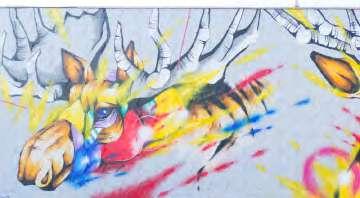
Create an Outcome Measurement Toolkit that can be used to support artists and organizations
city of kelowna & other levels of government
Provide mentorship to artists and organizations to develop business plans that include community impact as a driver for future initiatives
funders, business sector & capacity builders




Freely provide feedback about your experiences participating in cultural offerings

audience members & general public
how will you support this strategy?
2020-2025 Cultural Plan 32
strategy 2.5 demonstrate the impact of the creative sector to leverage additional resources and support
Initiatives that support this strategy will share the impact of the creative sector with new partners and potential funders in order to strengthen the case for investment and provide new resources for the creative sector
How could this be achieved?
Share the impact of your programs when reaching out for sponsorship
artists & cultural organizations
Strengthen private sector partnerships to facilitate new sponsorships of cultural initiatives
city of kelowna & other levels of government
Use the creative sector’s impact on the community to make informed investing decisions

funders, business sector & capacity builders





Support organizations that make a meaningful impact on your life and your community
audience members & general public
how will you support this strategy?
2020-2025 Cultural Plan 33
spaces
Utilizing new and traditional approaches for enhancing availability, affordability and accessibility of space for culture


Kelowna is home to museums, art galleries, community buildings, heritage buildings, theatres, outdoor venues and more. To ensure that needs are being met it is important that existing spaces are used to their highest potential. Shared production spaces, co-locating and using existing non-creative spaces for creative activities, are just some of the ways that we can use the spaces available in our community. This also gives the opportunity to protect heritage assets in our community, both built heritage and natural landscapes or local archaeological sites.
In addition to using available spaces to their best potential, we need to establish a commitment to the development of new cultural spaces. It has been identified that current infrastructure is outdated and no longer meets all of the sector’s needs.
goal 3 : optimize existing spaces
Improve the use of existing space and allow for alternative solutions to meet community needs.
Culture happens everywhere. Continuing to support the development of the Cultural District while also moving cultural programming into all parts of the community will ease space needs and create a more accessible environment for those who are not able to get downtown. It is important to be innovative in our approach to the use of space and encourage people to attend events in unique or nontraditional venues.
Major cultural facilities in Kelowna include the Rotary Centre for the Arts, Kelowna Art Gallery, Kelowna Community Theatre and five Kelowna Museums. The City owns these buildings, however except for the Kelowna Community Theatre, they are operated by non-profit organizations through Lease and Operating Agreements. The Kelowna Community Theatre is the only cultural facility both owned and operated by the City.
Our community is also home to many natural landscapes, local archaeological sites and built heritage. The Heritage Strategy, last updated in July 2015, assists the City in identifying, maintaining and protecting its valuable community heritage resources during a time of rapid growth and development. As of 2018, there were 206 registered heritage properties in Kelowna. The City of Kelowna invests $35,000 annually in Heritage Grants that assist homeowners with projects to restore their heritage homes.
how will we know if we are successful?
The evaluation criteria provided below is the starting point for evaluating this plan’s successful implementation. These criteria however, are not exclusive. Every community initiative that aligns with this plan will have its own way of measuring success. In addition, qualitative measures of success can be undervalued when there is a focus on quantitative measures.
evaluation criteria:
• Total dollars invested in built heritage
• Heritage owner knowledge of how to care for built heritage
• Total dollars invested in Kelowna Community Theatre, Kelowna Art Gallery, Rotary Centre for the Arts and Kelowna Museums Society facility improvements
• Number of Kelowna Community Theatre and Rotary Centre for the Arts (Mary Irwin Theatre) bookings
• Number of exhibits at Kelowna Art Gallery and Alternator Centre
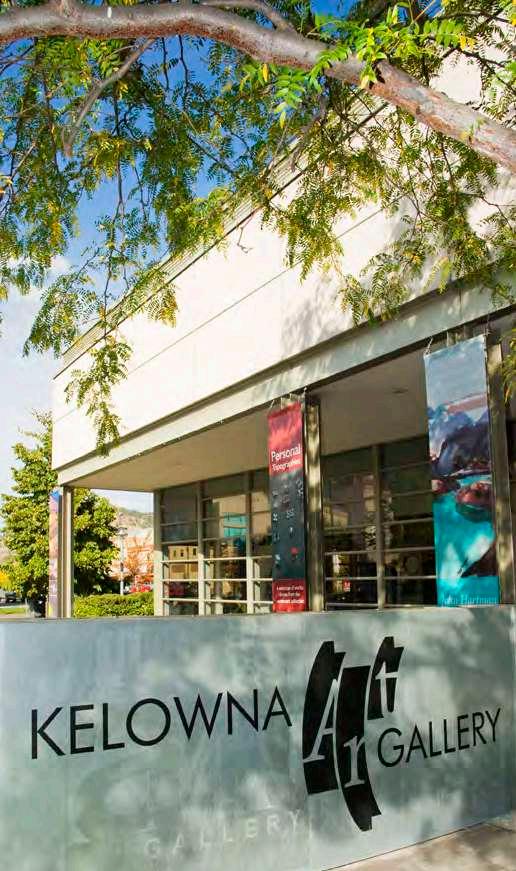
• Number of busk stops
• Number of permanent and temporary art exhibitions
• Venue usage and decreased turn-aways
2020-2025 Cultural Plan 35
spaces: optimize existing spaces
strategy 3.1 use existing space in new ways
Initiatives that support this strategy will encourage and support the innovative use of space within the community. This strategy will support modifications to existing space to improve its usage, accessibility and affordability. It will further support the concept that non-traditional space could be utilized for cultural programming.
How could this be achieved?
Plan cultural programs in parks or public spaces across the community
artists & cultural organizations
Compile and share an inventory of existing facilities which may be appropriate for a variety of cultural uses






city of kelowna & other levels of government
Create a paid local artist exhibition space in foyers or high traffic locations of local commercial establishments
funders, business sector & capacity builders
Be open to attending cultural events in non-traditional venues
audience members & general public
how will you support this strategy?
strategy 3.2 identify, preserve and protect the community’s heritage assets including


natural landscapes and local archaeological sites
Initiatives that support this strategy will leverage the benefits that local heritage assets provide to our community by preserving their original forms and promoting their value. Heritage assets are considered under a broad scope of natural landscapes, archaeological sites and built heritage.
How could this be achieved?
Educate the heritage owners on the methods for preserving and protecting their properties
artists & cultural organizations
Update the City of Kelowna Heritage Strategy
city of kelowna & other levels of government
Consider adaptive reuse of heritage buildings for commercial purposes
funders, business sector & capacity builders


Visit local heritage places, landscapes and archaeological sites that define our community
audience members & general public
how will you support this strategy?
2020-2025 Cultural Plan 36
strategy 3.3 animate community spaces with quality and accessible public art

Initiatives that support this strategy will enhance the appeal of public spaces utilizing public art. This strategy includes developing new pieces, maintaining existing pieces and promoting audiences to visit the collection.
How could this be achieved?
Install a temporary public art exhibition in a unique community space
Encourage developers to include quality public art installations within new construction
artists & cultural organizations funders, business sector & capacity builders



Develop a Public Art Masterplan
city of kelowna & other levels of government

Pick up a copy of Kelowna’s Public Art Guide and visit a piece close to your home or work

audience members & general public
how will you support this strategy?
2020-2025 Cultural Plan 37
spaces: optimize existing spaces
strategy 3.4 upgrade technologies to improve audience experience




Initiatives include updating technological equipment in presentation spaces and using technological approaches to sharing inventories.
How could this be achieved?
Develop a searchable, online inventory of your permanent collections and develop ways of sharing them




Take on a special project to develop a technological solution to an outstanding issue impacting the creative sector
artists & cultural organizations funders, business sector & capacity builders
Update sound and video equipment within the Kelowna Community Theatre
Share your ideas and experiences for the future use of technology with the groups hosting the programs and events you attend
audience members & general public city of kelowna & other levels of government
how will you support this strategy?
strategy 3.5 remove barriers and simplify access to space for cultural activities
Initiatives that support this strategy will foster an understanding of the challenges in accessing space for cultural activities and implement solutions when possible.
How could this be achieved?
Develop a unified voice for artists to advocate for and that help regulators understand the space needs of artists
Include arts professionals in the early planning of the development or redevelopment of space
artists & cultural organizations funders, business sector & capacity builders


Develop an understanding of the regulations that impact the ability of artists to access space and implement solutions where possible
Show your support for proposed changes that ease regulatory measures and support access to space
audience members & general public city of kelowna & other levels of government
how will you support this strategy?
2020-2025 Cultural Plan 38
What is Culture?
“Culture

2020-2025 Cultural Plan 39
is an encompassing word that describes a regions or cities attitude and demeanor. It lives in the infrastructure, it's economy, it's environment, it's people, it's parks and it's art. It is what collected people who are alike to live together."
goal 4 : commit to developing new facilities
Actively plan and seek opportunities for the advancement of new cultural facilities.
Kelowna’s major cultural facilities and spaces are concentrated in the Cultural District. While this has boosted the vibrancy of our downtown, it also creates several challenges especially in the areas of parking, transportation and overall accessibility. In addition, many of Kelowna’s facilities are aging and have structural deficits that limit the ability to mount sophisticated productions and negatively impact the audience experience. The Cultural Facilities Master Plan, expected to be released in late 2019, will provide direction and inform ongoing investments, decisions, priorities and actions. This report will be a starting point for demonstrating the need for more facilities.
However, it is imperative that the sector be able to demonstrate its need for new space. Without a strong, evidence-based understanding of the sector’s needs, it will be difficult to garner support and commitment for the development of new facilities.
how will we know if we are successful?
The evaluation criteria provided below is the starting point for evaluating this plan’s successful implementation. These criteria however, are not exclusive. Every community initiative that aligns with this plan will have its own way of measuring success. In addition, qualitative measures of success can be undervalued when there is a focus on quantitative measures.
evaluation criteria:

• Inclusion of the Kelowna Community Theatre in the 10-year Capital Plan as a priority one item
• Inclusion of Island Stage redevelopment in the 10-year Capital Plan as a priority one item
• Total dollars committed towards cultural facility development by City of Kelowna

• Total leveraged dollars committed to support new facility development
• Development of a community amenity space within the former RCMP site
2020-2025 Cultural Plan 40
strategy 4.1 understand the current and future needs for new cultural facilities within the community
Initiatives that support this strategy will focus on preparing for opportunities to advance the development of new cultural facilities. Initiatives will help organizations in the creative sector understand their facility requirements and advocate for their needs.
How could this be achieved?
Develop an understanding of your organization’s facility needs, now and into the future

Inform yourself about the current needs in our community and what can be done to meet those needs


artists & cultural organizations funders, business sector & capacity builders

Build on the recommendations of the Cultural Facilities Master Plan
city of kelowna & other levels of government

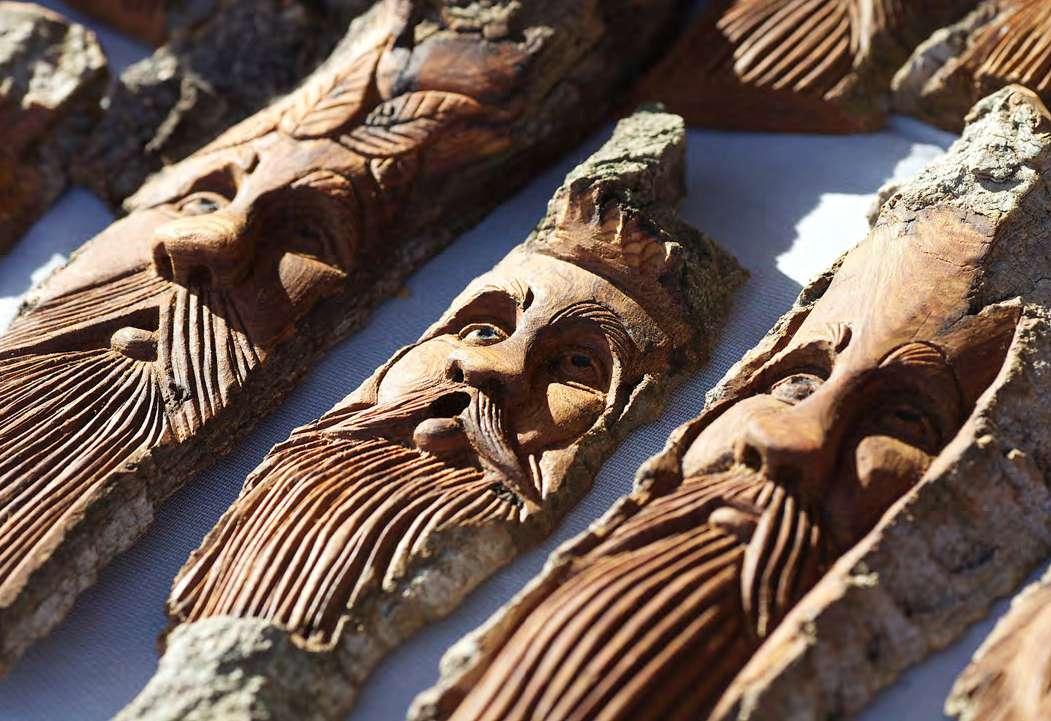
Rally with the creative sector to support the development of new cultural facilities
audience members & general public
how will you support this strategy?
2020-2025 Cultural Plan
41
spaces: commit to developing new facilities
strategy 4.2 establish future direction for the development or redevelopment of cultural facilities


Initiatives that support this strategy will commit to a course of action for the development of our cultural infrastructure and garner support for cultural facility development projects.
How could this be achieved?
Create a capital endowment fund and plan to redirect a small portion of earned revenue to capital infrastructure development
artists & cultural organizations
Plan for the development of a new Kelowna Community Theatre and Island Stage
city of kelowna & other levels of government
Plan for the addition of artist live/work studios when developing new mixed-use spaces
funders, business sector & capacity builders
Support the fundraising efforts of your favourite cultural organization
audience members & general public
how will you support this strategy?
strategy 4.3 find creative solutions to garner support for the construction of new cultural facilities including traditional and nontraditional funding models
Initiatives that support this strategy will develop innovative ways to fund facility development and mobilize the community to rally behind the development of new cultural spaces.
How could this be achieved?
Actively search and apply for unique funding opportunities to support new facility development
artists & cultural organizations
Investigate alternative models of facility development and unique capital funding solutions
city of kelowna & other levels of government
Partner with the public and creative sectors for the development of mixed-use creative hubs
funders, business sector & capacity builders



Start a crowdfunding campaign with friends and family for small capital projects





audience members & general public
how will you support this strategy?
2020-2025 Cultural Plan 42
What is Culture?
“Culture is what enriches life. It is the thing that adds sparkle to normal life.”
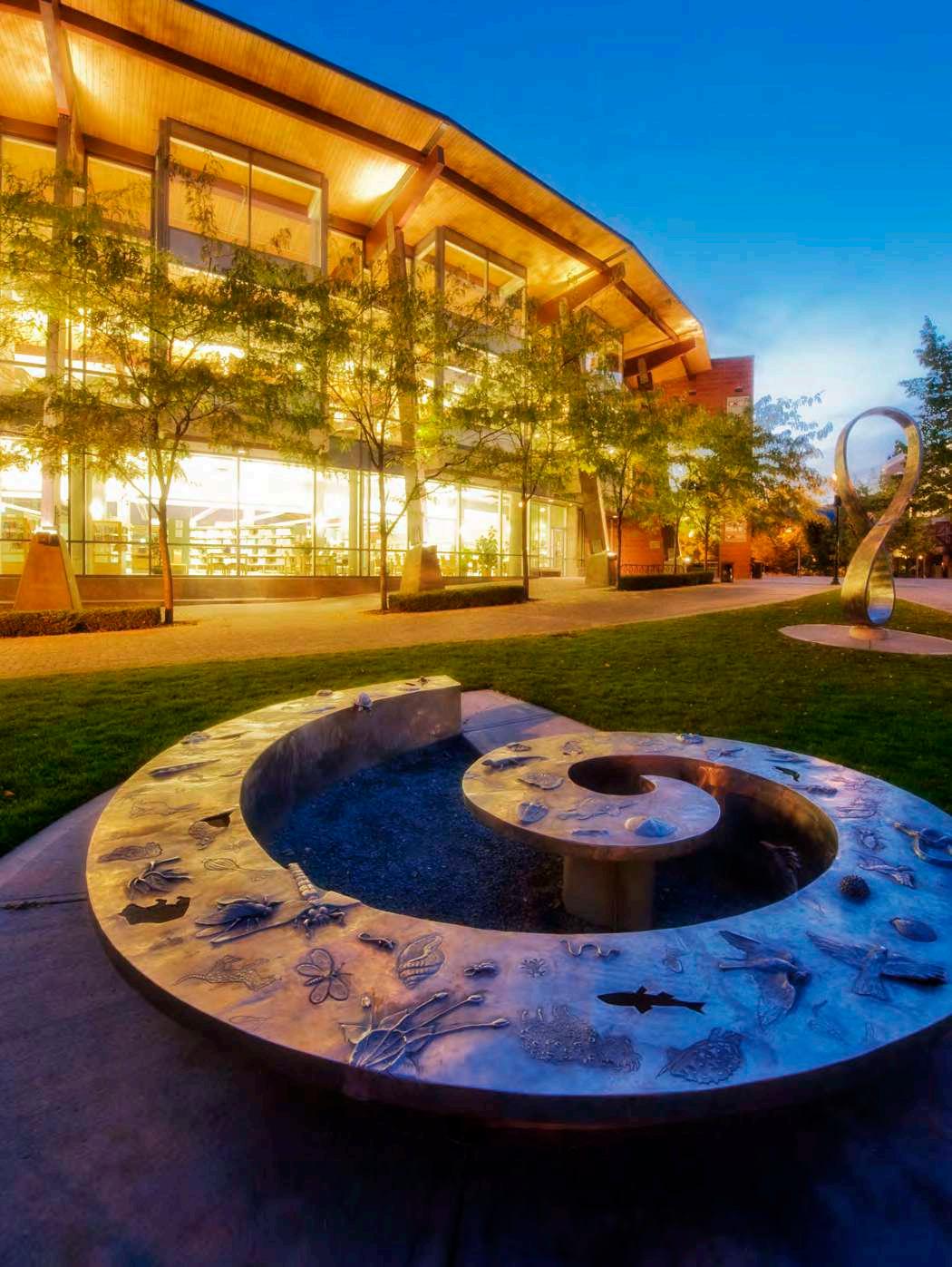
2020-2025 Cultural Plan 43
spaces: commit to developing new facilities
strategy 4.4 increase available production space for local artists
Initiatives that support this strategy will encourage the development of artist production spaces through funding programs and creating unique opportunities to host artists and fulfill their space requirements.
How could this be achieved?
Enhance the animation of artist galleries and creative spaces
artists & cultural organizations
Implement a Cultural Infrastructure Grant Program to improve access, partnership opportunities and better leverage funding

city of kelowna & other levels of government
Find opportunities to incorporate an artist in residence program to advance your company mission
funders, business sector & capacity builders





Have an emerging artist create a unique piece of handcrafted jewelry or clothing for you or as a special gift for someone you care about
audience members & general public
how will you support this strategy?
2020-2025 Cultural Plan 44
strategy 4.5 assess and explore the development of storage facilities between cultural organizations
Initiatives that support this strategy encourage collaborative approaches to tackling storage challenges in efficient and costeffective ways, and that reduces the creative sector’s overall storage needs.
How could this be achieved?
Collaborate with other organizations that have similar needs when searching for storage availability


Provide in-kind support by allowing arts and culture organizations to use your excess space
artists & cultural organizations funders, business sector & capacity builders


Create a central special event equipment hub for common event supplies
city of kelowna & other levels of government


Temporarily loan items from your personal collection to arts organizations to enhance their cultural offerings while reducing their storage needs
audience members & general public
how will you support this strategy?
2020-2025 Cultural Plan 45
We see a community which...
proactively welcomes and encourages the discovery of new experiences and art forms has meaningful and ongoing consultation with our First Nation hosts and provides new opportunities for Indigenous voice and expression
tackles challenges critically and creatively with an open spirit
Partnerships and cooperation

Leverage the value that culture contributes to the community
Innovation
invests in infrastructure, artists and non-profit organizations as a way to build character and identity
has distinct urban centres that understand their histories and promote their uniqueness while encouraging flow between each one
showcases its histories through its people, activities, buildings, landscapes, sites and stories is a leader in building collaborations and increasing quality of life for future generations
fosters innovation, attracts and retains people in its workforce embraces and celebrates diversity and is open and welcoming to all is recognized as a four-season destination with a rich variety of high-quality arts, culture and heritage experiences
Goal 2: Understand our impact
Goal 4: Commit to developing new facilities
Actively plan and seek opportunities for the advancement of new cultural facilities
Accountability and fiscal responsibility
Goal 1: Increase contribution of resources Develop a variety of approaches to increase support for the creative sector’s spaces, capacity, vitality and connections

Goal 3: Optimize existing spaces Improve the use of existing space and allow for alternative solutions to meet community needs
Accessibility, diversity and inclusion
Goal 6: Boost vitality at the street level Create excitement and activity throughout Kelowna
Goal 5: Learn from our past Engage the public in the protection and preservation of Kelowna’s human and natural history and bring stories about our past to the forefront
Goal 7: Support a viable creative sector Enhance administrative, financial, management and governance systems that create a strong foundation for the future
Goal 10: Convene and connect Bring the creative sector together for dialogue, exchange and action
Goal 9: Broaden the reach Incorporate culture within other sectors as an integral piece of community growth

Goal 8: Share our story Celebrate local activities, initiatives and successes with the broader community

STRATEGIC INVESTMENTS
foster deliberate investments of time, money and people into demonstrated outcomes
SPACES use new and traditional approaches for enhancing the availability, affordability and accessibility of spaces for culture
VITALITY
animate the community with a blend of programs, services and events that promote artistic excellence and share Kelowna’s history
CAPACITY build on the creative sector’s ability to respond to changing demands and new opportunities
CONNECTIONS promote ongoing interactions between people, sectors and disciplines

KEY THEMES AND GOALS
VISION GUIDING
PRINCIPLES
SPACES
Goal 9: Broaden the reach
9.1 Expand the role of youth in the creative sector
Goal 7: Support a viable creative sector
9.2 Encourage participation in the arts as a method of provoking thoughtful conversations about local issues
7.1 Foster a diversified funding approach by non-profit cultural organizations
Goal 5: Learn from our past
Goal 3: Optimize existing spaces
INVESTMENTS
9.3 Support cultural programming that promotes social inclusion and addresses important social issues
7.2 Create strong governance, management and administrative systems that are appropriate for an organization’s lifecycle stage
5.1 Honour the importance and share the history and culture of Indigenous people with a focus on the local syilx/Okanagan People
3.1 Use existing space in new ways
Goal 1: Increase contribution of resources
9.4 Encourage arts programming in non-arts mandated organizations with a focus on the development of new partnerships
7.3 Use a common language between trainers, consultants, resource centres and organizations when discussing organizational capacity and health
Spark interest in our history and share the value of preserving our heritage
3.2 Identify, preserve and protect the community’s heritage assets including natural landscapes and local archaeological sites
1.1 Increase funding to local organizations with a focus on multi-year and core operating funding
1.2 Inform community members about opportunities to become involved with cultural organizations
9.5 Ensure the needs of the creative sector are appropriately captured in City plans and policies
7.4 Mobilize the creative sector to take intentional action on truth and reconciliation
Goal 10: Convene and connect
10.1 Facilitate dialogue and collective action between people with similar interests
7.5 Connect artists and organizations with professional development, mentoring and capacity building training
Establish a framework for including the voice of Indigenous artists and cultural leaders in the creative sector
3.3 Animate community spaces with quality and accessible public art
3.4 Upgrade technologies to improve audience experience
1.3 Promote fair wages for arts professionals and support strategies aimed at attracting skilled creative workers and enterprises to Kelowna
Tell stories about the history of our community and the land we live on
3.5 Remove barriers and simplify access to space for cultural activities
1.4 Develop funding that strengthens relationships and fosters a more inclusive community that is respectful to all cultures
1.5 Invest in cultural infrastructure
10.2 Explore opportunities for the broader involvement of local educational institutions in developing and supporting local artists, organizations and initiatives
10.3 Bring regional, provincial and national conferences or events to Kelowna
Goal 8: Share our story
Facilitate networking between cultural stakeholders across the Okanagan region
10.4
8.1 Highlight the successes of Kelowna’s creative sector 8.2 Build broader and deeper relationships with audiences
Strengthen linkages between heritage and cultural tourism
Goal 4: Commit to developing new facilities
10.5 Encourage community awareness and collaboration to advance the Cultural Plan strategies
8.3 Make information about cultural events, programs and services easy to find for residents and visitors
8.4 Promote arts, culture and heritage experiences, as a reason to live in and visit Kelowna
8.5 Foster cultural advocates
6.1 Expand live music venues and local live music opportunities
4.1 Understand the current and future needs for new cultural facilities within the community
6.2 Celebrate multiculturalism and the growing diversity of our community
6.3 Amplify participation in public events by reducing barriers to attending
4.2 Establish future direction for the development or redevelopment of cultural facilities
6.4 Support and celebrate Indigenous arts and culture
6.5 Increase the number of new and innovative artistic experiences offered in Kelowna Goal 6: Boost vitality at street level
4.3 Find creative solutions to garner support for the construction of new cultural facilities including traditional and non-traditional funding models
4.4 Increase available production space for local artists
4.5 Assess and explore the development of shared storage facilities between cultural organizations
2.1 Use a coordinated approach to measure the impact of the creative sector on the community that includes looking beyond economic multipliers
2.2 Increase community awareness and stakeholder knowledge of the benefits and impact of culture in the community
2.3 Build on the role of the creative sector in tourism and economic development
2.5 Demonstrate the impact of the creative sector to leverage additional resources & support Goal 2: Understand our impact
2.4 Support artists and organizations with the tools and knowledge necessary to measure, track and modify programs to improve community impact
The strategies as presented are to be driven by cultural organizations, the business sector , government agencies and Kelowna citizens through community initatives. Sample community initiatives to support the strategies are outlined throughout the plan.
STRATEGIC
VITALITY CAPACITY CONNECTIONS
STRATEGIES
5.2
5.3
5.4
5.5
vitality
Animate the community with a blend of programs, services and events that promote artistic excellence and share Kelowna’s history
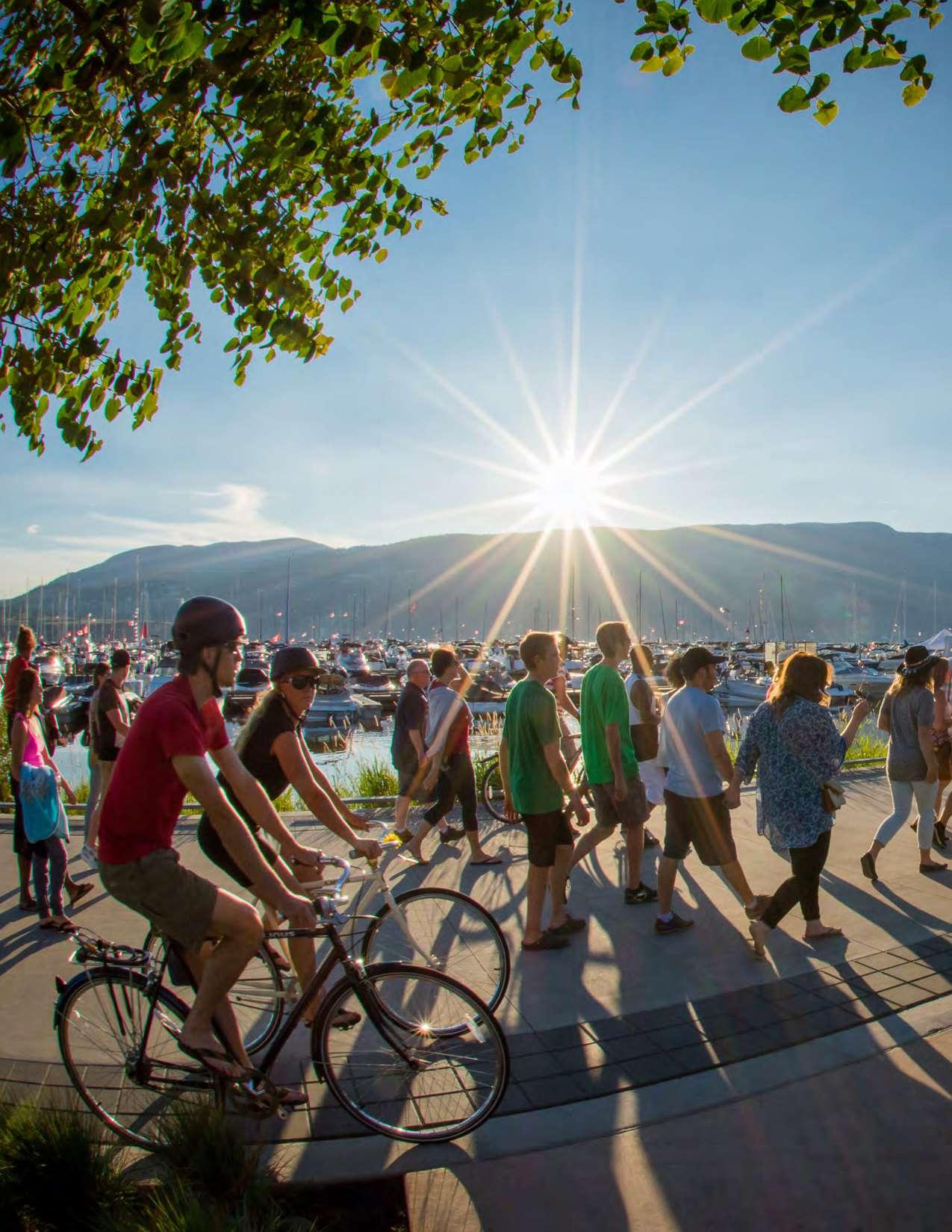
By fully understanding our history and honouring the land, people and cultures that make our community great, we will work collectively towards a stronger future.
Nurturing the skills of local artists and showcasing Kelowna’s unique cultural offerings will make our city more creative and more attractive to residents and visitors alike. This will require animating the streets throughout the city and offering more programs, services and events that people want to participate in.
As a community we must be willing to learn, celebrate and showcase our human, artistic and cultural diversities.

goal 5 : learn from our past
Engage the public in the protection and preservation of Kelowna’s human and natural history and bring stories about our past to the forefront.
Understanding our past allows us to understand our present. Getting the public to engage with our history builds curiosity about where we came from.
During the summer, walking tours of the Cultural District are offered by the City and Kelowna Museums. These tours showcase the district’s past and present and provides participants with a unique perspective on Kelowna’s evolution as a community. Programs and initiatives like this allow residents to be a tourist in their own back yard and teaches visitors about our community’s historical value.
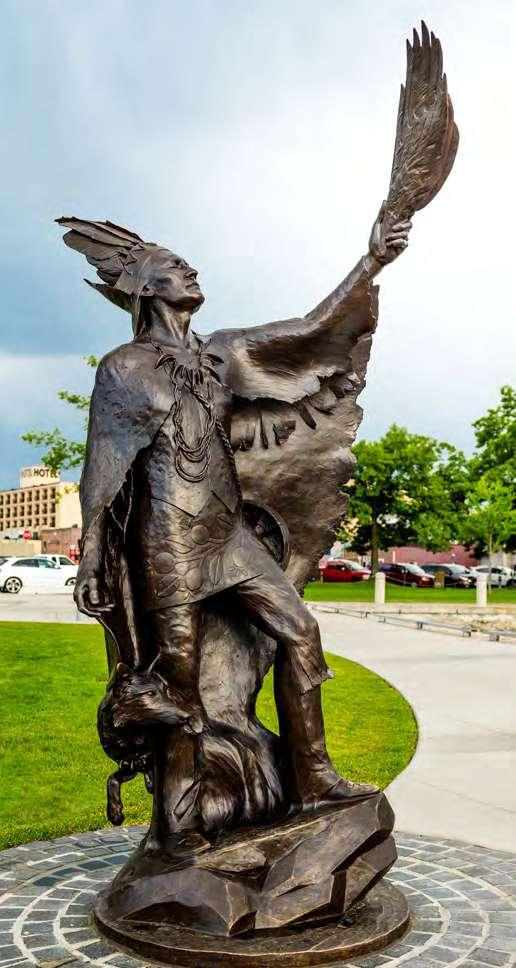
While Kelowna’s settler history has been widely shared within our community, the pre-settler history has been largely been left out. The syilx/Okanagan People have occupied this place since time immemorial and their way of life was disrupted by the arrival of settlers in the 1800’s. Pre-settler history is an integral component of where we have come from and the time to tell these stories is long overdue.
how will we know if we are successful?
The evaluation criteria provided below is the starting point for evaluating this plan’s successful implementation. These criteria however, are not exclusive. Every community initiative that aligns with this plan will have its own way of measuring success. In addition, qualitative measures of success can be undervalued when there is a focus on quantitative measures.
evaluation criteria:

• Number of properties on the heritage register (remains steady or increases)
• Number of natural landscapes and local archaeological sites identified for protection
• Number of events and people attending annual Heritage Week celebrations
• Number of students participating in the Okanagan Regional Heritage Fair
• Number of residents and visitors who attend the Cultural District Walking Tours
• Number of visitors to Kelowna Museums
2020-2025 Cultural Plan 49
vitality: learn from our past
strategy 5.1 honour the importance and share the history and culture of indigenous people with a focus on the local syilx/okanagan people
Initiatives that support this strategy will provide opportunities to share the important history of our land and the culture and practices of the syilx/Okanagan People.
How could this be achieved?
Use the nsyilxc n language on signage
Be aware of cultural symbols and their potential misuse on everything from marketing materials to corporate entertaining






artists & cultural organizations funders, business sector & capacity builders
Provide training to all civil servants about the history of Indigenous peoples
city of kelowna & other levels of government
Become educated on the history and culture of the syilx/Okanagan People
audience members & general public
how will you support this strategy?
strategy 5.2 spark interest in our history and share the value of preserving our heritage
Initiatives that support this strategy will encourage people in the community to learn about our human and natural histories and understand the value of preserving those histories within our everyday lives.
How could this be achieved?
Create a social marketing campaign around the value of preserving our community’s heritage
Share interesting facts about Kelowna’s history and local heritage sites with local and visiting customers
artists & cultural organizations funders, business sector & capacity builders




Increase support to the Heritage Grant Program
Visit a local heritage site and learn about its unique history
audience members & general public city of kelowna & other levels of government
how will you support this strategy?
2020-2025 Cultural Plan 50
e
strategy 5.3 establish a framework for including the voice of indigenous artists and cultural leaders in the creative sector
The strategy is supported by initiatives that involve Indigenous artist and cultural leader representation at all levels of the organization, from artists and program delivery to board members. Initiatives will leverage the value that unique perspectives bring to the creative sector.

How could this be achieved?
Include Indigenous representation on boards and committees where it is mutually beneficial to everyone involved
artists & cultural organizations
Work collectively with local Indigenous leaders to develop an Indigenization Strategy
Adopt the United Nations Declaration on the Rights of Indigenous Peoples as a reconciliation framework
funders, business sector & capacity builders





Take part in conversations, share your stories and the stories of your ancestors
audience members & general public city of kelowna & other levels of government
how will you support this strategy?
2020-2025 Cultural Plan 51
vitality: learn from our past
strategy 5.4 tell stories about the history of our community and the land we live on


Initiatives that support this strategy will offer opportunities to learn about our natural and human history and correct inaccurate portrayals of the past.
How could this be achieved?
Consider sharing local history as a component of cultural programming
artists & cultural organizations
Improve the use of heritage panels, cultural kiosks and heritage signage to tell stories about our history
city of kelowna & other levels of government
Take back the N'ha-a-itk (Ogopogo) story and return it to its true meaning and connection between water and life
funders, business sector & capacity builders
Preserve the intangible by telling your stories and sharing your native language with your children and grandchildren
audience members & general public
how will you support this strategy?
strategy 5.5 strengthen linkages between heritage and cultural tourism
Initiatives that support this strategy will boost and leverage the benefits that heritage and cultural tourism bring to our community. Initiatives will enhance the economic impact of culture in Kelowna and increase the desirability of Kelowna as a place to visit and enjoy cultural experiences.
How could this be achieved?
Work directly with hospitality industry experts to promote Kelowna’s high value heritage sites as visitor destinations
artists & cultural organizations
Host a local Heritage Forum connecting heritage enthusiasts and tourism professionals
city of kelowna & other levels of government
2020-2025 Cultural Plan
Offer products tailored in time with the calendar of local events – fairs, festivals, gatherings
funders, business sector & capacity builders








Explore local traditions, customs, rituals, festivals, myths and legends
audience members & general public
how will you support this strategy?
52
What is Culture?

2020-2025 Cultural Plan 53
“Culture is transmitted, through language, material objects, ritual, institutions, and art, from one generation to the next."
goal � : boost vitality at the street level
Create
Culture draws people to visit our community, creates an engaging atmosphere for residents and builds a vibrant and unique community identity.
Kelowna’s downtown is home to the Cultural District. This area continues to experience significant growth and the densification plan for the downtown core will increase the need to continue to boost vitality at the street level.
Kelowna currently has more than 70 pieces of public art displayed around the city, from Kelowna International Airport to the waterfront. Pieces include murals, sculptures and cultural elements integrated into our infrastructure. These pieces enrich our public spaces while fostering a sense of place and emotional attachment to Kelowna’s urban environment.
Each year from mid-June until late September, Festivals
Kelowna places eight artist decorated pianos in parks and public spaces for residents and visitors to enjoy through their Pianos in Parks program. These public pianos are located along the lakefront, around downtown, and in unique spaces like Roxby Square in Rutland and at the Kelowna Memorial Cemetery.
During the summer months, “Parks Alive!” presents 47 concert events 5-6 days a week from early July to the end of August featuring more than 225 local, regional, and touring artists across multiple musical genres, performing in more than 18 parks all over our community. Finally, the “Kelowna Buskers Program” provides 16 designated ‘Busk Stop’ locations throughout downtown and the lower Mission area to encourage and support ‘street style’ performances year-round. These programs animate public spaces, helping bring life and sound to the streets of Kelowna. We are a community with a passion for live music and have the privilege of having a large community of emerging and established musicians willing and able to entertain residents and visitors.
how will we know if we are successful?
The evaluation criteria provided below is the starting point for evaluating this plan’s successful implementation. These criteria however, are not exclusive. Every community initiative that aligns with this plan will have its own way of measuring success. In addition, qualitative measures of success can be undervalued when there is a focus on quantitative measures.
evaluation criteria:
• Number of live music events, venues and attendees
• Support to Indigenous arts and culture initiatives and celebrations
• Diversity of organizations, festivals and programs


• Number of busker permits issued
• New public art pieces unveiled
• Number of outdoor events held in community spaces by type and attendance
2020-2025 Cultural Plan 54
excitement and activity throughout Kelowna.
strategy 6.1 expand live music venues and local live music opportunities
Initiatives that support this strategy will advance the promotion of live music in Kelowna, optimize and increase awareness of available spaces and create opportunities to present the talents of local musicians for larger audiences.
How could this be achieved?
Have a common hashtag to promote live music and live music venues in Kelowna (e.g. #YLWMusic)

Hire local musicians or entertainers for your next company party or to liven up your venue and increase foot traffic
artists & cultural organizations funders, business sector & capacity builders




Create a Live Music Strategy
Donate a few dollars to a busker when you are impressed with their performance

audience members & general public city of kelowna & other levels of government
how will you support this strategy?
55
vitality: boost vitality at the street level
strategy 6.2 celebrate multiculturalism and the growing diversity of our community
Initiatives that support this strategy provide collaborative opportunities to learn about, celebrate and honour the growing cultural diversity of Kelowna. Initiatives include supporting celebrations, adapting policies and stimulating dialogue.
How could this be achieved?
Host an annual multicultural festival to celebrate the cultural diversity of Kelowna
artists & cultural organizations
Convene an ongoing roundtable of multicultural organizations
city of kelowna & other levels of government
Ensure your company honours diversity in its mission statements, core values, written policies, press releases, etc.
funders, business sector & capacity builders
Attend an event or workshop that celebrates or teaches about cultural practices that are not your own
audience members & general public
how will you support this strategy?
strategy 6.3 amplify participation in public events by reducing barriers to attending
Initiatives that support this strategy will improve accessibility to public events by simplifying planning of smaller scale events, lowering ticket costs for those with economic barriers and bringing arts and culture events to all corners of our community.
How could this be achieved?
Take your programming outside of your existing space and into the communities that you are serving
artists & cultural organizations
Complete the City of Kelowna Outdoor Events Strategy
city of kelowna & other levels of government
Partner with presenting organizations to provide event tickets to seniors with restricted income
funders, business sector & capacity builders








Pay it forward: if you are unable to use your event tickets, donate them to a local social organization


audience members & general public
how will you support this strategy?
2020-2025 Cultural Plan 56
What is Culture?
“Culture is that indefinable feeling of a place. It’s the sum of the emotional, artistic, and professional parts of a city."

2020-2025 Cultural Plan 57
vitality: boost vitality at the street level
strategy 6.4 support and celebrate indigenous arts and culture
Initiatives that support this strategy will include collaborative efforts to support Indigenous cultural traditions and celebrations, current cultural practices and the work of Indigenous artists with the aim of building meaningful and lasting relationships with Indigenous artists and cultural leaders.
How could this be achieved?
Work collaboratively with a local Indigenous artist to present their work within your organization’s context
artists & cultural organizations
Provide financial support to National Indigenous Peoples Day

city of kelowna & other levels of government
Consult with syilx creators in meaningful and ongoing ways, and provide opportunities for syilx expression

funders, business sector & capacity builders




View and purchase art by syilx artists
audience members & general public
how will you support this strategy?
2020-2025 Cultural Plan 58
strategy 6.5 increase the number of new and innovative artistic experiences offered in kelowna
Initiatives that support this strategy will encourage the creative sector to experiment with new ways of offering services, lead to the creation of new ideas and opportunities and shift the community’s perspective on the creative sector
How could this be achieved?
Take a risk with a new program offering
Fund risky, new initiatives in the creative sector
artists & cultural organizations funders, business sector & capacity builders



Support new community projects with the Cultural Grants Program

city of kelowna & other levels of government

Try a new cultural activity that you are curious about

audience members & general public
how will you support this strategy?
2020-2025 Cultural Plan 59
capacity
Build on the creative sector’s ability to respond to changing demands and new opportunities
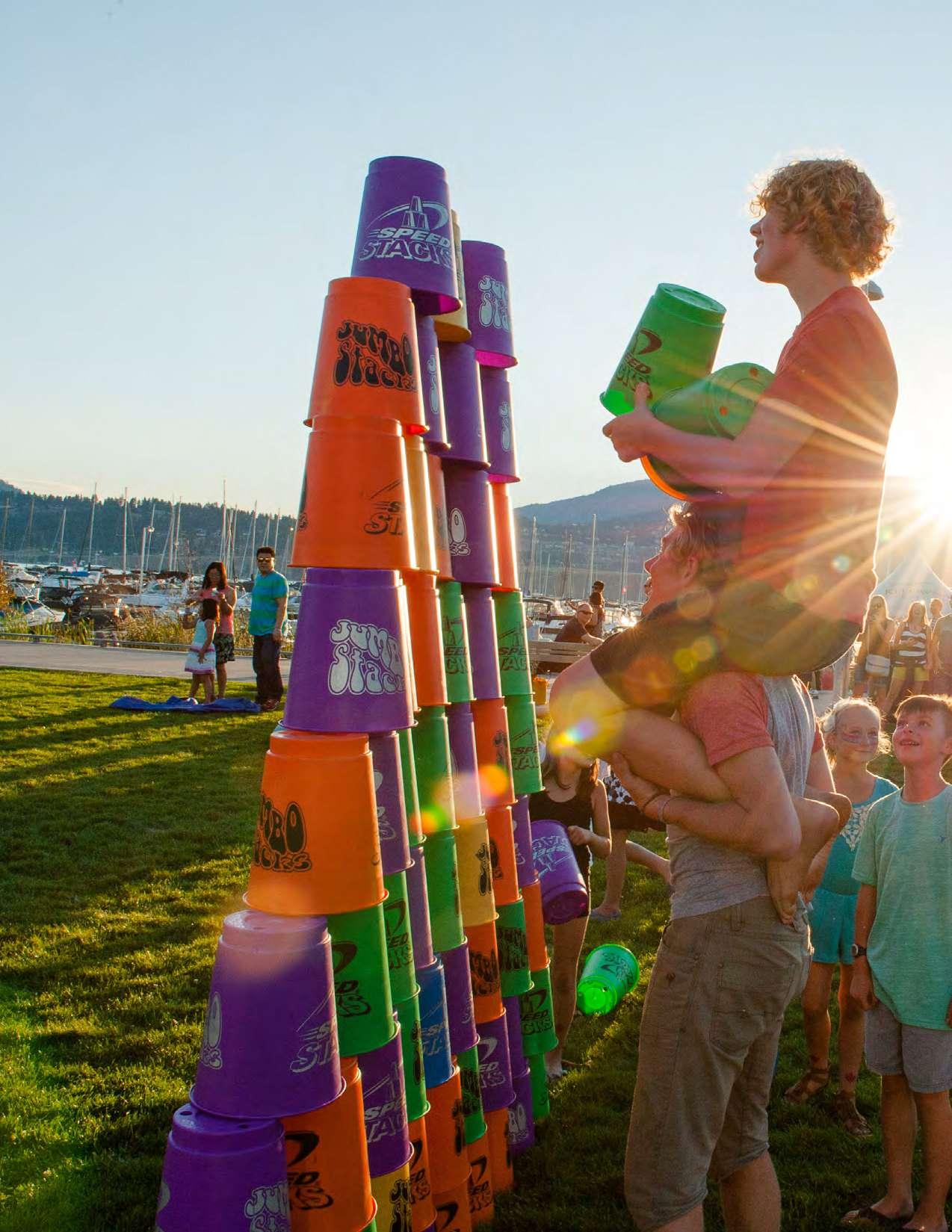
A community’s needs change significantly over time as a result of new social realities, new technologies and generational differences. Artists and organizations need to adapt to these changes if they want to be successful and sustainable over the long-term. To do this, they need to have a clear understanding of their mission, governance, financial resources and administrative systems.
This section of the plan is about how to build up the creative sector’s capacity to meet our community’s future needs. As part of that, it calls on all stakeholders to be honest about where they stand in relation to the syilx/Okanagan People and their role in working towards reconciliation.
goal 7 : support a viable creative sector
Enhance administrative, financial, management and governance systems that create a strong foundation for the future.
It is important to the City of Kelowna that arts, culture and heritage organizations are successful. Therefore, the City is committed to supporting these organizations in their capacity building efforts based on their current lifecycle stage. Using a lifecycle approach to providing support empowers organizational leaders to identify the challenges they face and the steps they need to take to continue developing.
Each year, the City dedicates $30,000 towards Organization Development Grants for the non-profit sector. These grants allow non-profit organizations to pursue initiatives that grow their capacity and sustainability.
Over the next several years, an important component of these capacity building efforts will be to look at our relationship with the syilx/Okanagan People. In order to build lasting change, both the City and non-profit organizations will need to shift the way we do business.
“Creating frameworks and approaches that are meaningful, relatable, and relevant for syilx people are essential components of strong and long-lasting bridges between the City of Kelowna and the syilx / Okanagan Nation. Part of this work requires that a co-created vision be developed between the City of Kelowna and the syilx People. A fundamental principle that must be interwoven throughout every aspect of this work is safety and freedom – more specifically, freedom from exploitation and tokenism. To visually and meaningfully portray syilx culture, art, and expression, a strong and secure foundation is required – in other words, the unseen, systemic barriers, oppressive policies, exclusive decision making, and othering must be acknowledged and addressed in order to get to the place we all want to be.”
(Carrie Terbasket, 2019. Weaving Our Collective Threads: Offering a Pathway for Syilx Creativity Within the City of Kelowna)
how will we know if we are successful?
The evaluation criteria provided below is the starting point for evaluating this plan’s successful implementation. These criteria however, are not exclusive. Every community initiative that aligns with this plan will have its own way of measuring success. In addition, qualitative measures of success can be undervalued when there is a focus on quantitative measures.
EVALUATION CRITERIA:
• Self-reported governance improvements
• Vacancies on boards of directors
• Initiatives undertaken by organizations and their outcomes (e.g. increased revenues, decreased expenses, new programs, new members, etc.)
• Number of people attending cultural competency training opportunities
• Self-reported learning that results from cultural competency training
• Initiatives undertaken to support action on reconciliation

• Total dollars invested in the capacity building of organizations
• Amount of additional funding organizations are able leverage as a result of municipal contributions
2020-2025 Cultural Plan 61
capacity: support a viable creative sector




strategy 7.1 foster a diversified funding approach by non-profit cultural organizations




Initiatives that support this strategy will assist non-profit organizations in the transition towards a diversified funding model with a nearly even split between earned revenue, grants and funding and donations and sponsorship.
How could this be achieved?
Complete a valuation inventory for event, facility and organization sponsorship opportunities
artists & cultural organizations
Encourage organizations to develop 3 to 5-year financial forecasts


city of kelowna & other levels of government
Host training opportunities focused on social enterprise development and increasing earned revenues
funders, business sector & capacity builders
When choosing a charity to support, select a local cultural organization
audience members & general public
how will you support this strategy?
strategy 7.2 create strong governance, management and administrative systems that are appropriate for an organization’s lifecycle stage
Initiatives that support this strategy will provide a framework for helping organizations respond to challenges, improve their sustainability and build-up their capacity and resilience.
How could this be achieved?
Update or create policy manuals that align with current legislation and best practices
artists & cultural organizations
Develop an incubator program for new cultural organizations to help them build a solid operational foundation
city of kelowna & other levels of government
Host a lunch and learn for volunteers in the non-profit sector focusing on an area of your expertise
funders, business sector & capacity builders
Encourage organizations that you are a member of to develop and share policies that affect your participation
audience members & general public
how will you support this strategy?
2020-2025 Cultural Plan 62
strategy 7.3 use a common language between trainers, consultants, resource centres and organizations when discussing organizational capacity and health

Initiatives that support this strategy will ease the process of learning and communicating about organizational health by creating a standard terminology for talking about capacity building and organizational strength.
How could this be achieved?
Learn about the elements of organizational health and how they impact the capacity of your organization
artists & cultural organizations

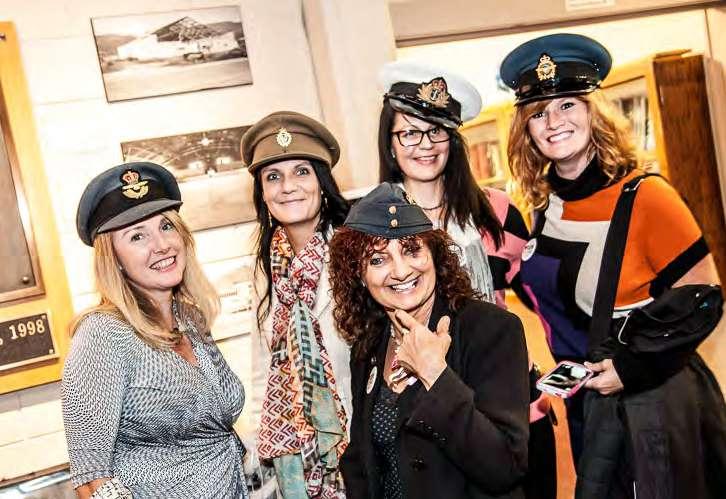
Establish a capacity building program that includes other funders, cultural organizations, and local consultants
city of kelowna & other levels of government
Align language and expectations used in grant programs with the common language used to talk about capacity and organizational health
funders, business sector & capacity builders




Attend an Annual General Meeting of an organization you are a member of to understand the overall health of the organization
audience members & general public
how will you support this strategy?
2020-2025 Cultural Plan 63
capacity: support a viable creative sector




strategy 7.4 mobilize the creative sector to take intentional action on truth and reconciliation
Initiatives that support this strategy will teach the community about the legacy of residential schools and advance the process of truth and reconciliation through education, understanding and actions that align with the Truth and Reconciliation Commission 94 Calls to Action.
How could this be achieved?
Use cultural programming to advance the Truth and Reconciliation Commission Calls to Action
artists & cultural organizations
Support Indigenous cultural organizations in offering educational programming
city of kelowna & other levels of government
Take cultural competency training and adapt your services to meet the needs of the syilx/Okanagan People
funders, business sector & capacity builders
Learn about Indigenous history, develop an understanding of what can be done and be willing to take action toward reconciliation
audience members & general public
how will you support this strategy?
strategy 7.5 connect artists and organizations with professional development, mentoring and capacity building training
Initiatives that support this strategy will provide the creative sector with education and training opportunities to further their professional skills and capacity. Initiatives will strengthen the creative sector’s efficiency, productivity and growth.
How could this be achieved?
Acknowledge that you are not in this alone and ask for support before a crisis hits
artists & cultural organizations
Continue efforts to enhance organizational capacity through the City of Kelowna Organization Development Grant program
city of kelowna & other levels of government
Maximize the use of technology to provide 24/7 access to capacity building training


funders, business sector & capacity builders




Learn about what makes strong organizations
audience members & general public
how will you support this strategy?
2020-2025 Cultural Plan 64
What is Culture?
“Culture

2020-2025 Cultural Plan 65
defines who we are as a society - it reflects our values."
connections
Promote ongoing interactions between people, sectors and disciplines

Most people have heard the phrase, “the whole is greater than the sum of its parts.” People and organizations can accomplish more by working together than they can on their own. This is why it is important to connect creative disciplines with each other, and with other sectors. This includes connecting non-profit organizations with forprofit enterprises.
Developing mutually beneficial relationships between diverse people and organizations facilitates the advancement of initiatives that serve the greater community needs. Collaboration and cooperation on projects that advance these needs will be integral to the creative sector’s success and will help develop a stronger creative community.
Connecting arts and culture organizations with the community will promote audience development and help build a strong group of residents who will be better positioned to advocate for investment in culture. Taking collective action locally, regionally and nationally will help to reach common goals on a larger scale.
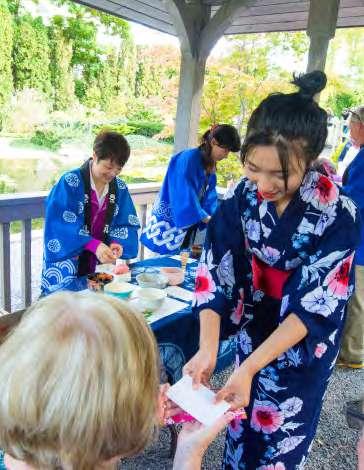
goal 8: share our story

Celebrate local activities, initiatives and successes with the broader community.
Local artists and organizations regularly accomplish great things in their fields and receive awards for their work. For example, local artists often receive funding to present their work abroad, Kelowna-based musicians are touring the world, and Kelowna has been listed as one of the Top 10 Mid-Size Cities for Culture Days, 5 years in a row. And this is just a small sample. We need to be loudly celebrating these accomplishments!
It is important to encourage broader participation in cultural programming and develop deep and loyal relationships between audiences, artists, venues and organizations. Recent initiatives such as the #KelownaCulture Facebook Page, developed by the Arts Council of the Central Okanagan, have promoted audience development by encouraging the listing of all cultural activities in a centralized location. This initiative had long been desired by the community.
It is also important to grow the audience that comes from outside Kelowna. As shown in the Kelowna Creative Sector Economic Impact Assessment report, approximately 30% of all cultural facility or event attendees come from outside Kelowna. This creates an opportunity to work with local tourism professionals to promote Kelowna as a place that has more than just wine, golf and beaches.
how will we know if we are successful?
The evaluation criteria provided below is the starting point for evaluating this plan’s successful implementation. These criteria however, are not exclusive. Every community initiative that aligns with this plan will have its own way of measuring success. In addition, qualitative measures of success can be undervalued when there is a focus on quantitative measures.
EVALUATION CRITERIA:
• Success stories shared by the City, local organizations and the media
• People reached for each marketing initiative undertaken

• Total reach per dollar invested
• Success of marketing initiatives that promote audience growth (e.g. measuring the use of promo codes in ticket sales)
• Increased support to culture provided by Tourism Kelowna (e.g. listings, promotions, direct funding, etc.)
2020-2025 Cultural Plan 67
connections: share our story
strategy 8.1 highlight the successes of kelowna’s creative sector
Initiatives that support this strategy will increase awareness among residents, businesses and within the creative sector itself, about the positive impacts the sector has on our community and quality of life.
How could this be achieved?
Share success stories with the media, funders and the public through organization newsletters
artists & cultural organizations
Acknowledge the contributions of non-profit organizations and local artists in community reports and newsletters
city of kelowna & other levels of government
Feature the successes of local cultural organizations and artists in local media
funders, business sector & capacity builders
Share your positive arts and culture experiences on social media
audience members & general public
how will you support this strategy?
strategy 8.2 build broader and deeper relationships with audiences




Initiatives that support this strategy will increase the number of people who attend cultural programming or events, and create loyal and ongoing relationships between the creative sector and residents of Kelowna.
How could this be achieved?
Adapt your programs to address the needs of different populations and grow your audience
artists & cultural organizations
Develop a Cultural Activity Passport initiative to encourage broad participation in cultural programs
city of kelowna & other levels of government
Offer tickets to cultural events as a unique way to reach new clientele
funders, business sector & capacity builders




Send your feedback about a recent event, activity or program that you attended to the hosting artist or organization


audience members & general public
how will you support this strategy?
2020-2025 Cultural Plan 68
What is Culture?
“Culture is a collective reflection of the values, beliefs, experiences, and history of a specific community. It is expressed through art, music, literature and also through activities that bring people together, like community gardens, community dinners, and park events. Culture should represent locals."
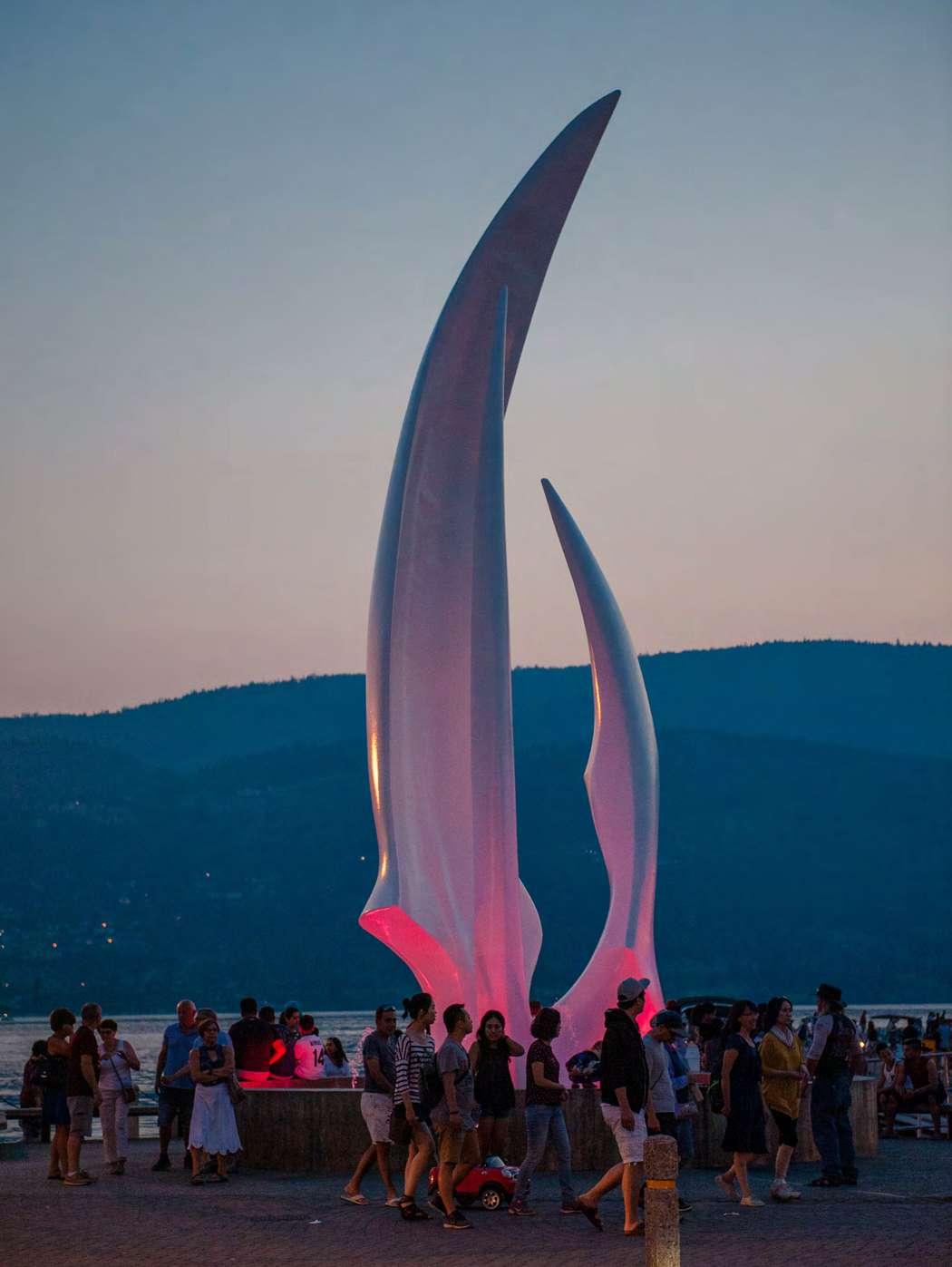
2020-2025 Cultural Plan 69
connections: share our story
strategy 8.3 make information about cultural events, programs and services easy to find for residents and visitors






Initiatives that support this strategy will streamline the marketing efforts of artists and organizations to increase and broaden the reach of programs, events and activities. These initiatives will increase awareness and make information easier to access.
How could this be achieved?
Post all events and activities using the #KelownaCulture Facebook page
Provide a community bulletin board in your establishment that showcases upcoming community events
artists & cultural organizations funders, business sector & capacity builders
Develop a Cultural District Marketing Strategy
Know where to find information on cultural events and share that source with others


audience members & general public city of kelowna & other levels of government
how will you support this strategy?
strategy 8.4 promote arts, culture and heritage experiences as a reason to live in and visit
kelowna
Initiatives that support this strategy will help the creative sector inspire Kelowna residents with high quality cultural programing, as well as support the development of new activities and festivals that will draw audiences to Kelowna.
How could this be achieved?
Seek out opportunities to grow your audience beyond those who live in Kelowna
Promote cultural experiences as a way to attract talent and a reason to relocate to Kelowna
artists & cultural organizations funders, business sector & capacity builders


Work directly with Tourism Kelowna to promote the creative sector to potential visitors
Plan to have family and friends visit Kelowna to attend cultural events and programs
audience members & general public city of kelowna & other levels of government
how will you support this strategy?
2020-2025 Cultural Plan 70
strategy 8.5 foster cultural advocates
Initiatives that support this strategy will inspire and incentivize members of the community to become cultural advocates who support the creative sector.

How could this be achieved?
Become a member of your governing association and actively contribute to discussions and projects that advance your work
artists & cultural organizations
Actively participate in provincial and national associations that advocate for increased support to arts and culture
city of kelowna & other levels of government
Bring people together to articulate their needs and concerns to decision makers



funders, business sector & capacity builders


Become an advocate for the arts
audience members & general public
how will you support this strategy?
2020-2025 Cultural Plan 71
goal 9 : broaden the reach
Incorporate culture within other sectors as an integral piece of community growth.
As community issues become more complex and the need to work collectively increases, the creative sector has an opportunity to bring people together to work on common issues and improve our quality of life.
Partnerships need to be developed between arts organizations and other non-profits, the business sector and non-arts mandated organizations. Organizations in the creative sector and their partners can help each other tap into new markets, promote their brands and develop new audiences and clients.
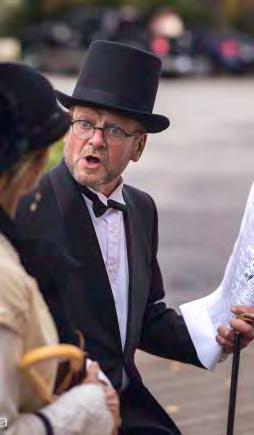
The City of Kelowna currently has a Cultural Policy that covers arts, culture and heritage. The City also has the Sister City Policy, which provides direction for the development of sister city relations. Continuing to update these policies, or creating news ones, will be important to ensure that local government is meeting the needs of Kelowna’s creative sector.
how will we know if we are successful?
The evaluation criteria provided below is the starting point for evaluating this plan’s successful implementation. These criteria however, are not exclusive. Every community initiative that aligns with this plan will have its own way of measuring success. In addition, qualitative measures of success can be undervalued when there is a focus on quantitative measures.
evaluation criteria:
• City of Kelowna policy updates
• Reported youth involvement in the creative sector as volunteers, board members or artists

• Implementation of an Artist in Residence program
• Number of people engaged in artistic development
• Number of people engaged as audience members
• Self-reported change in perspective and skills of participants
2020-2025 Cultural Plan 72
strategy 9.1 expand the role of youth in the creative sector

Initiatives that support this strategy will tap into the skills and perspectives that young people bring to cultural organizations and the community as artists, decision makers and volunteers.
How could this be achieved?
Appoint young people to your board or other decision making roles
artists & cultural organizations
Host a Youth Forum to discuss arts and culture opportunities and challenges
city of kelowna & other levels of government
Offer funding specifically to youth to help them develop their careers while staying in the community
funders, business sector & capacity builders





Get involved by sharing your skills and talents
audience members & general public
how will you support this strategy?
73
2020-2025 Cultural Plan
connections: broaden the reach
strategy 9.2 encourage participation in the arts as a method of provoking thoughtful conversations about local issues
Initiatives that support this strategy will promote art as a way of raising awareness and prompting thoughtful conversations about social issues in our community.
How could this be achieved?
Produce and present artistic works about the human impact on our natural environment
Choose an issue that aligns with your company’s mission and support an art project related to that issue
artists & cultural organizations funders, business sector & capacity builders
Host a temporary art exhibition that highlights an important community issue
city of kelowna & other levels of government
Visit, discuss and share works of art that provoke thoughtful conversations
audience members & general public
how will you support this strategy?
strategy 9.3 support cultural programing that promotes social inclusion and addresses important social issues






Initiatives that support this strategy will use cultural programming to take action on social issues and make it easier for people who have been marginalized to participate in our community.
How could this be achieved?
Work collaboratively with the Journey Home Society and other social organizations on initiatives that benefit the community
Support projects that work across multiple sectors and promote social inclusion in new ways
artists & cultural organizations funders, business sector & capacity builders


Develop an Artist in Residence Program that supports current social issues
city of kelowna & other levels of government


Volunteer at an art therapy program or a class that supports artists with diverse abilities
audience members & general public
how will you support this strategy?
2020-2025 Cultural Plan 74
What is Culture?
“The ways in which we engage, connect, and express ourselves within our communities."

2020-2025 Cultural Plan 75
connections: broaden the reach

strategy 9.4 encourage arts programming in non-arts mandated organizations with a focus on the development of new partnerships
Initiatives that support this strategy will develop new partnerships between the creative sector and other community organizations or businesses, in order to broaden the reach of cultural programming and its benefits.
How could this be achieved?
Seek partnerships with major sports or community events to enhance those events by incorporating cultural programming

Sell products created by local artisans
artists & cultural organizations funders, business sector & capacity builders

Facilitate and support the development of Community Art projects


city of kelowna & other levels of government

Take a day for your family to participate in the Cultural District Walking Tour starting at the Laurel Packinghouse
audience members & general public
how will you support this strategy?
2020-2025 Cultural Plan 76
strategy 9.5 ensure the needs of the creative sector are appropriately captured in city plans and policies
Initiatives that support this strategy will bring culture to the forefront of City planning and policy efforts.
How could this be achieved?
Participate in public engagement and stakeholder consultation opportunities for City plans and policies

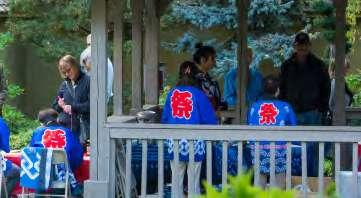
artists & cultural organizations
Ensure the needs of the creative sector are addressed in the Official Community Plan and Transportation Master Plan updates
city of kelowna & other levels of government
Participate in consultation opportunities for City plans and policies
funders, business sector & capacity builders




Participate in consultation opportunities for City plans and policies
audience members & general public
how will you support this strategy?
2020-2025 Cultural Plan 77
What is Culture?
“Culture is important to the well-being of the community, the quality of life for all residents and the economic vibrancy of the city. It helps to create a place where people want to live with celebrations, activities and spaces."

2020-2025 Cultural Plan 78
goal 10 : convene and connect
Bring the creative sector together for dialogue, exchange and action.
“No one can whistle a symphony. It takes a whole orchestra to play it.” – H.E. Luccock
Our community has shown great strength when rallying together to achieve a common goal. For example, in 2018 a fire severely damaged the 147-year-old Fleming House. The building was slated for demolition, but heritage advocates banded together to highlight the site’s importance and today it stands with a new, protective roof on it.
Every quarter, approximately 15 local arts organizations convene for the Kelowna Arts and Culture Roundtable to discuss challenges, successes and possible collaborations on upcoming projects. The roundtable facilitates learning and sharing within the sector, and provides members with an opportunity to plan collective action.
There are also opportunities for people in Kelowna’s creative sector to connect with like-minded individuals from outside Kelowna. In 2018, Breakout West and the BC Museums Association Conference both took place in Kelowna, giving locals the opportunity to network with hundreds of colleagues from around the province. In the fall of 2019, Arts BC’s 40th Anniversary Conference will be held in Kelowna, offering skills development and collaboration with community arts leaders. Convening provincial and national conferences in our community has a positive impact on tourism and our economy, makes it easy for local arts professionals to participate in these events and gives our community the chance to show off our unique culture. Developing strong connections with individuals and organizations outside of Kelowna are crucial to advancing the strategies laid out in this plan.
how will we know if we are successful?
The evaluation criteria provided below is the starting point for evaluating this plan’s successful implementation. These criteria however, are not exclusive. Every community initiative that aligns with this plan will have its own way of measuring success. In addition, qualitative measures of success can be undervalued when there is a focus on quantitative measures.
EVALUATION CRITERIA:
• Number of organizations and artists participating in networking opportunities (roundtables)

• Number of times roundtables meet in a year
• Number of joint initiatives between creative sector organizations, artists and collectives
• Number of regional, provincial and national conferences held in Kelowna
• Number of local partners who help host these conferences

2020-2025 Cultural Plan 79
connections: convene and connect
strategy 10.1 facilitate dialogue and collective action between people with similar interests






Initiatives that support this strategy will bring people from the creative sector together to achieve common objectives. They will encourage the sharing of best practices and collectively develop solutions to common challenges.
How could this be achieved?
Attend and actively participate in the Arts and Culture Roundtable quarterly meetings
artists & cultural organizations
Create a local Artist Advisory Committee
city of kelowna & other levels of government
Allow space for brainstorming and collective problem solving when convening like-minded groups
funders, business sector & capacity builders
Share your thoughts and ideas with others with similar interests; work together to move the idea forward
audience members & general public
how will you support this strategy?
strategy 10.2 explore opportunities for the broader involvement of local educational institutions in developing and supporting local artists, organizations and initiatives
Initiatives that support this strategy will create mutually beneficial relationships between the local educational institutions and the creative sector.
How could this be achieved?
Increase student practicum placements in different types of cultural organizations
artists & cultural organizations
Partner on research projects with the local school district, UBC Okanagan or Okanagan College
city of kelowna & other levels of government
Partner on learning opportunities offered by Okanagan College and the Scotiabank Centre for Non-Profit Excellence
funders, business sector & capacity builders




Develop a greater appreciation of the arts by taking a class in art, music, history or literature
audience members & general public
how will you support this strategy?
2020-2025 Cultural Plan 80
strategy 10.3 bring regional, provincial and national conferences or events to kelowna
Initiatives that support this strategy will create an environment that attracts large-scale cultural conferences to Kelowna by seeking opportunities, supporting bids, hosting and developing partnerships to maximize visitor experiences.

How could this be achieved?
Bid to host your governing associations’ regional/provincial/national conferences
artists & cultural organizations
Provide support to develop proposals for the hosting of large scale, public cultural events
city of kelowna & other levels of government
Partner with event hosts to provide wrap-around services that improve visitor experiences
funders, business sector & capacity builders





Attend events that are of interest to you
audience members & general public
how will you support this strategy?
2020-2025 Cultural Plan 81
connections: convene and connect
strategy 10.4 facilitate networking between cultural stakeholders across the okanagan region


Initiatives that support this strategy will offer opportunities for people in the creative sector to meet colleagues from across the Okanagan Valley, discuss best practices and current events and find opportunities to expand their audiences. Initiatives will focus on developing mutually beneficial relationships that help expand the reach of local and regional programing.
How could this be achieved?
Get to know those who do similar work in a neighbouring municipality
artists & cultural organizations
Partner with other municipalities on an annual networking event for cultural organizations in the Okanagan
city of kelowna & other levels of government
Offer your space for networking events
funders, business sector & capacity builders
Get to know the artists who practice in our region. Be at the breakout exhibition or performance of the next big band
audience members & general public
how will you support this strategy?
strategy 10.5 encourage community awareness and collaboration to advance the cultural plan strategies




Initiatives that support this strategy will mobilize all levels of government, organizations, the business community, artists, audience members and the general public in the collective implementation of this plan. Stakeholders will be encouraged to align their own priorities with those of this plan. When everyone works together, we can achieve our vision.
How could this be achieved?
When updating programs or developing new initiatives, incorporate the priorities of the Cultural Plan
artists & cultural organizations
Align Cultural Grant funding with the objectives of the Cultural Plan
city of kelowna & other levels of government
Take part in a Share Your Own event and learn how your business can get involved in implementing the Cultural Plan
funders, business sector & capacity builders




Take the time to read the initiatives of the Cultural Plan and determine how you will participate
audience members & general public
how will you support this strategy?
2020-2025 Cultural Plan 82

appendix i: cultural plan advisory group
lindy
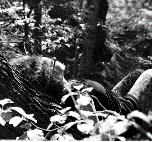
Linda’s passion is connecting people with something bigger than themselves. This passion has driven her professional journey through heritage, culture, and arts for 34 years. She believes we all long to connect, to be amazed, and to be transformed.
lucy
Lucy has enjoyed a diverse musical career, spanning over 35 years. She studied Clarinet to ABRSM Grade 8 in England, adding saxophone and flute along the way. This has allowed her to work as a soloist & in ensemble with orchestras, concert bands, jazz bands, and many musical theatre companies.

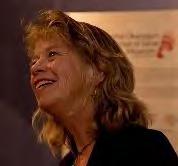
sonya
Sonya has been involved in the arts and culture sector in Kelowna since arriving in the community in 2007. She was the Program Coordinator for Festivals Kelowna for three years, has been on the Board of Directors for Creative Okanagan for 6 years, and was on the 2010 and 2018 BreakOut West Host Committee.



lars
Lars has been active artist in our community for the last 10 years. He started out landscaping and doing stonemasonry in the valley in his early twenties. He has been tattooing full time for the past seven years, and has painted murals in public and private spaces here in town.
leila (neverland)
naderi
Drawing from classical piano training, a childhood spent in Toronto’s children’s choirs including the Canadian Children’s Opera Chorus, Leila Neverland is breaking through the West Coast music scene with her powerful voice, thought provoking original music & timely lyrics.
As part of Tourism Kelowna’s Marketing & Communications team, Melissa handles social media and communication, which includes the promotion of Kelowna’s vibrant arts and culture scene, and its heritage. Melissa spends her free time enjoying concerts and local theatre productions in Kelowna.


erin
Erin is an award winning poet and performer with a Master of Fine Arts from UBCO. She is Executive Director of Inspired Word Cafe Society and Co-Artistic Director of the Fat Cat Children’s Festival.
karma
Karma has been the Executive and Creative Director of Creative Okanagan Artist and Event Development Society since January 2016, she worked at Okanagan College in Public Affairs for three years, and on BreakOut West in 2010 and 2018.
internal advisory group (city of kelowna)
paul reyes parks & building planning
ross soward policy & planning
geraldine parent k elowna community theatre
robert fine business and entrepreneu rial development
cory leslie finance

leah
Leah’s career, research & publication areas, education, and passions all lie in the fields of diversity and inclusion, equitable and social-justice driven practices, anti-racism, and intercultural awareness. She is the Local Immigration Partnership Coordinator at KCR Community Resources, a role dedicated to furthering the development of Central Okanagan as an inclusive, welcoming community for all newcomers.and immigrants.
Although her career was in health care and research, Jo has been a practising glass artist since the late 1970s. Her studio is in the Rotary Centre for the Arts and her work is featured at Hambleton Galleries. She lives downtown and loves the energy and synergy that the many cultural groups and arts activities bring to the city.

mike mcgreer corporate strategy and performance
lisa ruether communications
carlin bolt communications
chris babcock event development
jim gabriel active living & cu lture
84
digby
benwell
jo mckechnie
barker
a. widell
melissa mccluskey
sanford
lacoff
scott
survey demographics
ages
survey 1: visioning
july 16 – september 3 2018
A survey was launched on July 16, 2018 to kick-off the Cultural Plan engagement. The survey was made available at Park and Play events around the community in conjunction with a cultural footprint activity for children. The survey was also promoted through a database of arts, culture and heritage stakeholders, on kelowna.ca/culture, through the media, and on the City of Kelowna’s social media channels.
The purpose of the survey was to understand how the community defines and experiences culture in Kelowna. Questions focused on a definition of culture, cultural venues and locations, what current cultural activities respondents considered a success and any additional suggestions for ways to improve culture in Kelowna.
On September 3, 2018 the survey closed with a total of 180 responses. At the close of the survey, in addition to the responses received, there were:
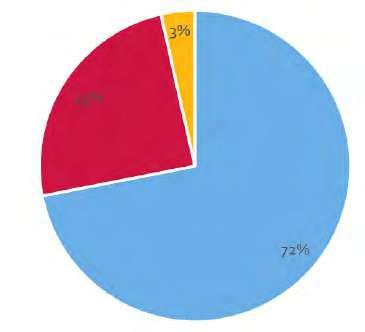
• 944 page views on Get Involved Cultural Plan
• 479 unique page views on Survey 1 – average time spent on page was 2 minutes and 53 seconds.


• 20 downloads of the 2012-2017 Cultural Plan
• 13 downloads of the Cultural Plan Mid-term Report Card
• 6 downloads of the Report to Council: Cultural Plan

findings
Respondents participated in culture through events, work or volunteer opportunities, community activities or programs, visiting creative spaces, history and exposure to different cultures.
Respondents participated in culture at cultural facilities, parks, in various neighbourhoods, and through exposure to multiculturalism at work or school.
genders

The community has a broad definition of culture including: arts, identity, history, society, ethnicity, traditions, music, theatre and beliefs.
Respondents believe that our community is currently doing well in several areas including events, heritage, promotion, organizations, support for programs, creative spaces and opportunities for collaboration.
Survey respondents identified the following areas of improvement:
• Financial support
• Creative spaces
• Promotion
• Events
• Heritage
• Public art
• Truth and Reconciliation
• Accessibility and inclusion
2020-2025 Cultural Plan 85 appendix ii: methodology for engagement
children’s cultural footprint activity
july
16 – august 23 2018 & january 20 2019
To engage the younger population, children aged 4-12 were provided with the opportunity to participate in a cultural footprint activity. While attending Park & Play events over the summer of 2018, or the Unplug and Play event in January of 2019, children were able to complete their own “cultural footprint” by gluing icons that represented cultural activities to a cardstock cut-out of a footprint. They were also able to add additional icons of their own if they wished. There were 119 cultural footprints created through the summer, and 66 completed at the Unplug and Play event. In total, 185 cultural footprints were created.

findings
All children identified at least one way of participating in culture in Kelowna. The types of activities that the children participated in were broken into 5 categories:
1. Performance: music | dance | theatre | spoken word | improvisation
2. Visual Arts: 2 and 3 dimensional | performance | fine or artisanal craft | site specific or temporary installation
3. Literary Arts: poetry | prose | storytelling
4. Media/new media: film | video | still photography
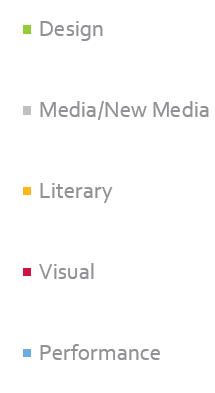
5. Design: fashion | graphic | industrial | interior
cultural footprint results

2020-2025 Cultural Plan 86 appendix
ii: methodology for engagement
survey 2: goals & strategies
september 15 2018 – march 31 2019
A second survey was launched in mid-September 2018. The survey was promoted through the arts and culture e-newsletter, the City’s website, social media channels and through the media.
On March 31, 2019 the survey closed with 237 respondents. The purpose of Survey 2 was to understand changes in community priorities since the 2012-2017 Cultural Plan and if goals should be added, removed or modified. Along with understanding these changing priorities, we aimed to understand what strategies respondents felt could be employed to achieve those goals. The questions provoked thought on what residents, artists, non-profit organizations, businesses or the government could do to achieve those goals.
In general, respondents felt that the goals of the 2012-2017 Cultural Plan goals were still relevant today.

Strategies for improving cultural programming and achieving the goals of the plan focused on support, accessibility and inclusivity, spaces and promotion.

Respondents who suggested additional support was required were looking for:
• additional support to facilities
• increases in funding to grant programs
• support to local Indigenous groups
• support for those participating in outdoor street performances
To make the creative sector more inclusive and accessible, respondents’ solutions included:
• improving parking availability
• supporting cultural diversity initiatives
• the extension of cultural activities outside of the downtown core
• subsidies to improve the affordability of cultural events
Many respondents said that the creative sector would benefit from more space for culture, including investment in the development of new cultural facilities - primarily Kelowna Community Theatre and Island Stage.
Respondents wanted to see an increased presence of cultural events and activities on social media and promotions to encourage participation in different cultural activities. There was a desire to see a one-stop location for cultural events in Kelowna.
2020-2025 Cultural Plan 87
findings
appendix ii: methodology for engagement
host your own engagement event grant program
january 15 – march 31 2019
On November 29, 2018 the Host Your Own Engagement Grant program was launched and applications were accepted until January 14, 2019. Successful applicants were granted $250-$500 to host a community discussion on arts, culture or heritage in any format they felt would best suit their group. Following the event, each host submitted a final report with their findings to be used in the shaping of the 2020-2025 Cultural Plan’s goals and strategies. A total of 18 applications were received, 14 grants were offered, and 13 events were hosted. Additional organizations hosted conversations and submitted their findings without a grant.
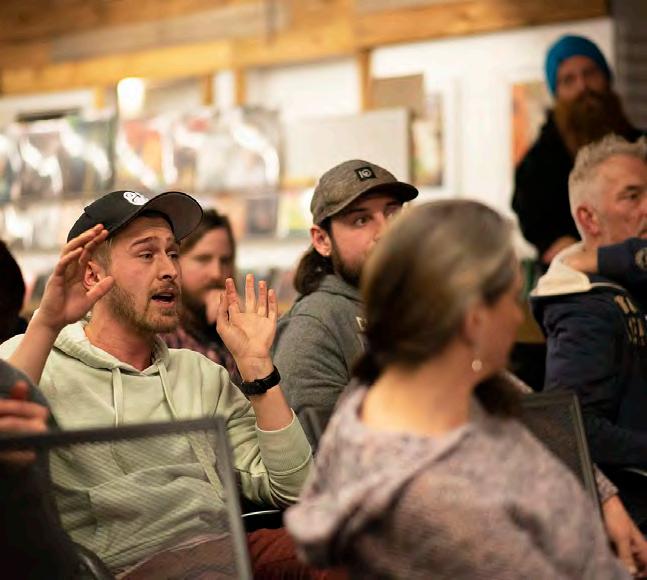
host your own engagement sessions held:
organizer topics
BC Interior Jazz Festival
Craig Siemens and Kris Hargrave
Kelowna Community Resources – Immigrant Services
Kelowna Art Gallery
Dena Milanese through Karis Support Society
Jo McKechnie
Kelowna Visual and Performing Arts Centre Society
UBCO African Caribbean Student Association
Eight Spaces Group Inc. dba Okanagan coLab
Inspired Word Café
Central Okanagan Heritage Society
Kelowna Arts Council
New Vintage Theatre Society
Music and performing arts
Live music
Multiculturalism
Visual arts
Healing through art
Life for the residents of the Madison
Facilities and broad creative sector
Multicultural/student led events
Live music and venue solutions
Literary arts
Heritage and history
Broad creative sector
Theatre and the performing arts
findings
Conversation topics were diverse and ranged from the need for cultural facilities, finding more and different kinds of affordable cultural spaces and enhancing the number of programs and services offered in the community.
A range of possible strategies to achieve a stronger creative sector were brainstormed. Along with these strategies, groups highlighted areas that they felt needed additional attention in the updated plan, such as the need to focus on supporting multiculturalism and the syilx/Okanagan People.
Two of the groups that hosted open community discussions convened additional meetings, without funding support, to begin work on the ideas generated at the original meeting. This was an unexpected and favourable outcome of the small grant program and we look forward to working with these community-led committees upon implementation of the plan.
2020-2025 Cultural Plan 88
young professionals open house at ubco
january 29 2019
An information booth was set up at the University of British Columbia Okanagan campus for students and faculty to give feedback about the goals and strategies of the Cultural Plan. A paper survey was available for people to take home if they wanted more time to reflect.

Promotion of youth engagement activities included use of City and local educational institutions social media channels, newsletters and digital screens. The CCTV at the Rotary Centre for the Arts and Kelowna Community Theatre also hosted the information and paper handouts were made available at various community events leading up to the application deadline. Posters were delivered to schools, as well as put up at various coffee shops and cultural venues in the community. Cultural Services staff also contacted teachers of arts disciplines across the public and private school systems. Teachers were encouraged to invite their students to participate and provide feedback in the process themselves. A total of 35 university students, professors and staff took part in the open house event.
findings
Attendees of the open house prioritized integrating culture into plans and processes and finding and using innovative funding approaches. Discussion and feedback at the open house focused on more networking opportunities between students and the creative sector, enhancing opportunities to showcase student art, more arts festivals and student involvement in community projects.
youth and young professionals forum
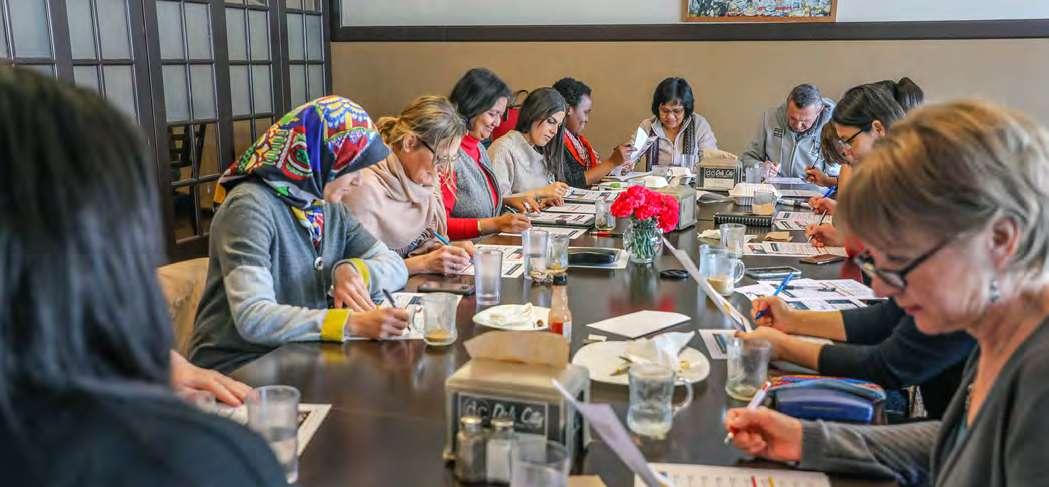
january 31 2019
Interested youth and young professionals between the ages of 16 and 26 came together to talk about the Cultural Plan and give feedback on what they would like to see achieved in our community. Attendees brainstormed their perfect vision of Kelowna and developed strategies for how our community could achieve those visions. The forum was advertised in coordination with the advertising of the Young Professionals Open House. Participants were asked to apply in advance of the event. A total of 12 youth from grade 11 through university attended the forum.
findings
Attendees prioritized enhancing cultural vitality at the street level, integrating culture into plans and processes and using innovative funding approaches. Conversations focused on better advertisement of events and programs available in our community, recognizing culturally diverse arts groups and cultures, and offering more support (financial, space, promotion) to artists in our community.
2020-2025 Cultural Plan 89
innovation centre chalk wall february 2019

To expand the ways people could provide feedback, the question, “How can we enhance arts, culture and heritage in Kelowna?” was posted on the chalk wall in Kelowna’s Innovation Centre. Chalk markers were provided, and anyone could write, draw or express their feedback on the board. The question remained on the board for three weeks and was filled with responses.
As well, cards with links to the survey were left by the board to provide participants with the opportunity to give further feedback if they were interested. The Chalk Wall was open to any member of the public who entered the Innovation Centre including the employees and members of the public.
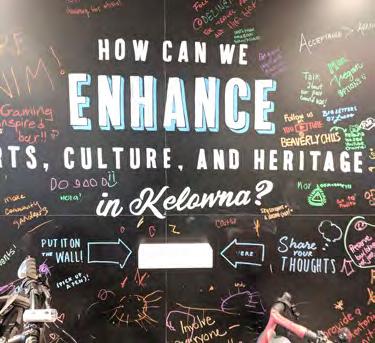


findings
The wall was hugely successful, and many unique ideas were generated. Comments were broad but focused on inclusivity, funding/ support and street level vitality. They demonstrated the desire to support LGBTQ2+ communities, First Nations programs/events and support for involving youth in the sector. Funding for artists, free programs/services to the community, equality among socioeconomic classes and ethnicity were common answers. Additionally, there was a desire for more events, higher diversity of events, more street art, and more activity in our community.

2020-2025 Cultural Plan 90
stakeholder events january – march 2019
A variety of additional workshops, open houses and interviews were held with cultural stakeholders. Conversations were led by Cultural Services staff, but the content was controlled by those participating in the discussions. Cultural Services staff also attended public events where interested individuals were able to talk about their thoughts on the plan.
personal and small group interviews
One-to-one interviews were held with interested representatives from Okanagan College, UBC Okanagan, School District 23 and the Kelowna Actors Studio. Interviews were also held with numerous City of Kelowna staff not directly involved in the Advisory Group but who are impacted by the plan’s content.
cultural services led workshops
group topics
Host Your Own Information Session
Facilities, spaces, connecting the community and integrating culture into plans and processes
Kelowna Museums Society Staff Heritage and facility development
Kelowna Museums Society Board
Heritage, facility development, integrating culture into plans and processes
Active Living and Culture Recreation Technicians Culture within municipal programming
Active Living and Culture Coordinators
Lived Experience Circle on Homelessness
Integrating culture into programming, improving culture for residents

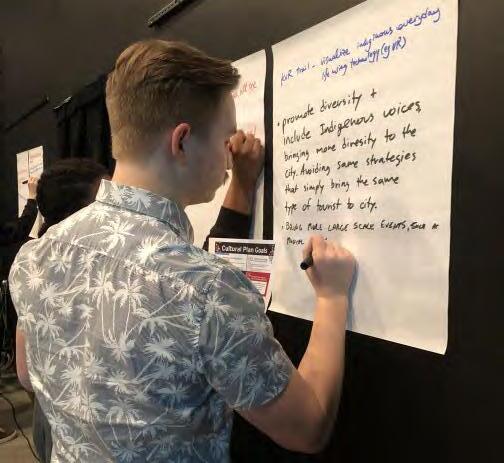
Cultural vitality at street level, social inclusion, reducing barriers
Visual arts, inclusivity, space and Staff
Alternator Centre for Contemporary Art Board
open house style public events
Park & Play – Ben Lee Park
Park & Play – Whitman Glen Park
Park & Play – Knox Mountain Park
Park & Play – Blair Pond Park
Unplug and Play Event
Okanagan Symphony Orchestra Open Dress Rehearsals (x2)
Unlock your Board’s Potential event at the Innovation Centre
Spring Board Governance Workshop at Capri Hotel
Wine and Cheese Tenant Social at the Innovation Centre
2020-2025 Cultural Plan 91 appendix ii: methodology for engagement
appendix ii: methodology for engagement
cultural facility master plan organization interviews
january - march 2019
Arts and culture organizations were asked to participate in a telephone survey regarding cultural facilities in Kelowna. The survey was used to inform this plan’s development and the development of the Cultural Facilities Master Plan. The questions focused strongly on the organization they represented, how they use spaces/facilities, the limitations they face with the available spaces, and how their needs could be better met.
The following groups completed an interview with either City of Kelowna staff or CitySpaces, a consulting firm engaged to support the development of the Cultural Facilities Master Plan:
Chamber Music Kelowna
Festivals Kelowna
Kelowna Community Theatre
Kelowna Museums Society
Arts Council of the Central Okanagan
Dolyna Ukrainian Cultural Society
Ballet Kelowna
Kelowna Community Music School
Kelowna Arts Council
Opera Kelowna Society
New Vintage Theatre Society
Alternator Centre for Contemporary Art
Kelowna Art Gallery
Theatre Kelowna Society
Kelowna City Concert Band Society
Cool Arts Society
Okanagan Chinese Canadian Association
Okanagan Symphony Orchestra Society
Centre culturel francophone de l’Okanagan
Ki-Low-Na Friendship Society
findings
Creative Okanagan Artist and Event Development Society
Kelowna Community Concert Association
Kelowna Visual and Performing Arts Centre Society
Kelowna Pipe Band
Kelowna Kiwanis Festival
Okanagan Festival Singers
Okanagan Historical Society
Federation of Canadian Artists Central Okanagan Chapter
Okanagan Society of Independent Filmmakers
Ponderosa Spinners, Weavers and Fibre Artists Guild
Kelowna Pride Society
Studio 9 School of the Arts
Central Okanagan Heritage Society
BC Old Time Fiddlers
Inspired Word Café
Okanagan Regional Library
Society of Friends of the Early Music Studio
Global Citizen Events Society
Inner Fish Theatre Society
Kelowna Innovation Centre
Kelowna-Kasugai Sister City Association
The findings from these interviews were broad and extensive. Detailed findings of this engagement activity can be found within the Cultural Facilities Master Plan, expected to be released in late 2019.
2020-2025 Cultural Plan 92
capstone project: data analysis
april 23 - june 25 2019
An opportunity was available to apply for a Capstone Project with the UBC Okanagan Masters of Data Science Program. This program was looking for unique community projects with data that needed to be analyzed. Cultural Services staff were successful in their application and three masters’ students started working with the Cultural Plan update project on April 23, 2019.
Over a period of two months, these students worked directly with Cultural Services staff to:
• Use data science techniques to clean and analyze the text data collected during the engagement activities;
• Visualize trends, patterns and other insights that may not be seen using more traditional methods of reviewing large quantities of information or, may be impacted by individual biases inherent in human analysis;
• Create an interactive map with ongoing data collection possibilities.
A variety of machine learning techniques were employed to objectively analyze the data including sentiment analysis, data visualizations and topic modelling.
findings
• Respondents aged 55+ prioritized enhancing existing support programs, optimizing existing cultural facilities and enhancing cultural vitality at the street level



• Respondents aged 25 or younger prioritized convening and connecting the cultural community and integrating culture into plans and processes and using innovative funding approaches
• The most important needs of the community, according to respondents, are more affordable spaces, financial help and more support to local groups
• Cultural organizations’ satisfaction with facilities gradually decreases as they move further away from the downtown core
• People are generally happier when they travel 14 kilometers or less to a cultural venue

2020-2025 Cultural Plan 93
think that integrating culture into plans & processes & using innovative funding approaches is important
think that optimizing existing cultural facilities is important
think that convening & connecting the cultural community is important
appendix ii: methodology for engagement
closing survey: draft cultural plan review july 19 - august 5 2019
Using the feedback provided from July of 2018 to the end of March 2019, a draft summary of the Cultural Plan was created. This summary included a Vision, Guiding Principles, Key Themes, Goals and Strategies. To ensure that the community feedback was reflected and that the plan supports the community’s ideas for the future of the creative sector, the draft was released to the public for feedback online and at public events. In addition to open dialogue at public events, an online survey was created and allowed for people to provide detailed feedback.
cultural services attended the following events:
• Arts on the Avenue event – Bernard Avenue
• Creative Sector Economic Impact Assessment Luncheon – Capri Hotel
• Dancing in the Park/Park & Play – Stuart Park
• Okanagan Regional Library – Downtown Branch
• Okanagan Regional Library – Rutland Branch
• Parkinson Recreation Centre lobby
• Rutland Community Market
A total of 266 people attended the booths set up around the community and took the time to learn about the Cultural Plan and give their feedback. Respondents to the online survey were primarily from the downtown (V1Y) area of Kelowna, representing 43.9 per cent of survey respondents, and were mostly residents/audience members or workers/volunteers for a cultural organization. 26.8 per cent of respondents were aged 45-54, and 19.5 per cent of respondents were either aged 55-64 or 25-34.
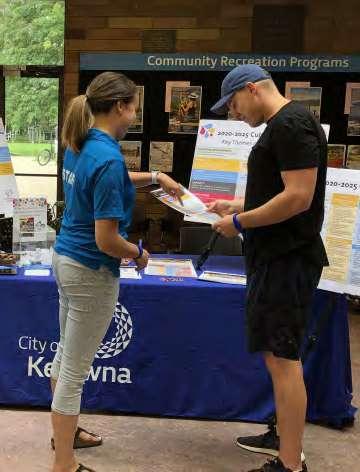

findings
Overall, the feedback confirmed that the draft plan covered the community’s needs and priorities. Respondents were happy with the increased focus on multiculturalism and celebrating diverse cultural traditions. They are excited to see how the plan will unfold through its implementation. Additionally, respondents were pleased with the inclusion of relationship building with the syilx/Okanagan People. A common piece of feedback that we received was the concern for rebuilding the Kelowna Community Theatre. Respondents highly prioritized the rebuilding of the theatre, as well as the development of other world class art and culture facilities. Other common comments focused on support for individual artists and more accessible events. Respondents were eager to see how the plan unfolds but were also concerned with how success would be measured.
2020-2025 Cultural Plan 94
1: increase contribution of resources


goal
Select a local cultural organization to support when choosing to donate to charities
Find a local cultural organization to give 1-2 hours per week as a board member or program volunteer
Increase fund ing to local organizations with a focus on multi-year and core operating funding
1.1
Develop culture specific funding opportunities
Actively search and apply for new funding opportunities
Inform communi ty members about opportunities to become involved with cultural organizations
Implement a volunteer program within the workplace
Clarify volunteer positions and promote opportunities to the community
Make the next book you purchase and read from a local author
Demand that artists are paid fairly for their work at events supported by your company
Review current practices for compensating arts professionals and make any necessary adjustments










Change current Cultural Grant Program to include multi-year funding and additional general operating support
Promote fai r wages for arts professionals and support strategies aimed at attracting skilled creative workers and enterprises to Kelowna
Commit to learning and understanding more about the diverse cultural groups that make up Kelowna
Work collectively as funders to develop a program that supports the sharing of multiculturalism with the broader community
Modify current programs or internal systems to better support relationship building with multicultural organizations










Promote volunteer opportunities in the creative sector through the Arts and Culture e-newsletter
De velop funding that strengthens relationships and fosters a more inclusive community that is respectful to all cultures
1.2
Ensure organizations that receive government funding compensate artists appropriately
1.3
Amend the current Cultural Grant Program to prioritize funding support for projects that promote greater diversity and relationship building
1.4
Partner with public funders and non-profit organizations to invest money in the development of long-term capital projects
1.5
Document your needs and be ready for opportunities that may arise to support infrastructure development
Invest in cultural i nfrastructure strategies & sample community initiatives


















Volunteer your carpentry, painting or other technical skills to support renewal of facilities goal 2: understand our impact
Include new cultural facilities and infrastructure regeneration in the capital plan
Use a coordina ted approach to measure the impact of the creative sector on the community that includes looking beyond economic multipliers
2.1
Complete community or organization surveys and participate in local focus groups
Share your story about how involvement in the creative sector has impacted you
Develop an innovative technology solution that can measure the impact of participation in the creative sector
Attend dinner and a show for your next date night
Learn about the impact culture has in our community
Freely provide feedback about your experiences participating in cultural offerings
Enhance the experience of visitors to cultural events by tailoring your offerings to align with major events
Determine a set of measurable criteria that demonstrates the creative sector’s impact
Increase communi ty awareness and stakeholder knowledge of the benefits and impact of culture in the community
2.2
Share success stories about community members who have benefited from your programs & services in organization newsletters or on social media
Provide mentorship to artists and organizations to develop business plans that include community impact as a driver for future initiatives
Support organizations that make a meaningful impact on your life and your community
Publish a Community Impact and Benefits of Culture Report every two years
Bui ld on the role of the creative sector in tourism and economic development
2.3
Present and promote an event that draws its audience from beyond Kelowna
Broadly share the Kelowna Creative Sector Economic Impact Assessment report
Support artists and organizations with the tools and knowledge necessary to measure, track and modify programs to improve community impact
2.4
Use the creative sector’s impact on the community to make informed investing decisions
Eliminate programs that do not demonstrate desired community impacts and focus efforts on those that do
Demons trate the impact of the creative sector to leverage additional resources and support Implement an online grant application and reporting program that allows for automated data collection
Create an Outcome Measurement Toolkit that can be used to support artists and organizations
Share the impact of your programs when reaching out for sponsorship
Strengthen private sector partnerships to facilitate new sponsorships of cultural initiatives
2.5
STRATEGIC INVESTMENTS
&
appendix iii: sample community initiative summary
strategies
sample community initiatives
3: optimize existing spaces
goal
Create paid local artist exhibition spaces in foyers or high traffic locations of local commercial buildings
Use existing space in new ways
3.1
Be open to attending cultural events in non-traditional venues Update the City of Kelowna Heritage Strategy
Identify, preserve and protect the community’s heritage assets including natural landscapes and local archaeological sites
Pick up a copy of Kelowna’s Public Art Guide and visit a piece close to your home or work
Share your ideas and experiences for the future use of technology with the groups hosting the programs and events you attend
Consider adaptive reuse of heritage buildings for commercial purposes
Encourage developers to include quality public art installations within new construction
Take on a special project to develop a technological solution to an outstanding issue impacting the creative sector Plan cultural programs in parks or public spaces across the community
3.2
Visit local heritage places, landscapes and archaeological sites that define our community Develop a Public Art Masterplan
Include arts professionals in the early planning of the development or redevelopment of space
Educate heritage owners on methods for preserving and protecting their properties
Animate community spaces with quality and accessible public art
3.3
Install a temporary public art exhibition in a unique community space
Upgrade technologies to improve audience experiences










Develop a searchable, online inventory of your permanent collections and develop ways of sharing them




Remove barriers and simplify access to space for cultural activities Compile and share an inventory of existing facilities which may be appropriate for a variety of cultural uses Update sound and video equipment within the Kelowna Community Theatre
3.4
3.5
Rally with the creative sector to support the development of new cultural facilities
Support the fundraising efforts of your favourite cultural organization
Develop a unified voice for artists to advocate for and that help regulators understand the space needs of artists
Develop an understanding of the regulations that impact the ability of artists to access space and implement solutions where possible
Show your support for proposed changes that ease regulatory measures and support access to space goal 4: commit to developing new facilities
Understand the current and future needs for new cultural facilities within the community
4.1
Inform yourself about the current needs in our community and what can be done to meet those needs
Develop an understanding of your organization’s facility needs, now and into the future






Build on the recommendations of the Cultural Facilities Master Plan
Establish future direction for the development or redevelopment of cultural facilities
4.2
Plan for the addition of artist live/work studios when developing new mixed-use spaces
Create a capital endowment fund and plan to redirect a small portion of earned revenue to capital infrastructure development
Plan for the development of a new Kelowna Community Theatre and Island Stage
Find creative solutions to garner support for the construction of new cultural facilities including traditional and non-traditional funding models
4.3
Start a crowdfunding campaign with friends and family for small capital projects
Have an emerging artist create a unique piece of handcrafted jewelry or clothing for you or as a special gift for someone you care about
Temporarily loan items from your personal collection to arts organizations to enhance their cultural offerings while reducing their storage needs
Partner with the public and creative sectors for the development of mixed-use creative hubs
Actively search and apply for unique funding opportunities to support new facility development
Find opportunities to incorporate an artist in residence program to advance your company mission
Investigate alternative models of facility development and unique capital funding solutions
Increase available production space for local artists
4.4
Enhance the animation of artist galleries and creative spaces










Implement a Cultural Infrastructure Grant Program to improve access, partnership opportunities, and better leverage funding
Assess and explore the development of storage facilities between cultural organizations
4.5
Provide in-kind support by allowing arts and culture organizations to use your excess space
Collaborate with other organizations that have similar needs when searching for storage availability
Create a central special event equipment hub for common event supplies










SPACES strategies & sample community initiatives strategies & sample community initiatives
5: learn from our past
goal
Honour the importance and share the history and culture of Indigenous people with a focus on the local syilx/Okanagan People
5.1
Be aware of cultural symbols and their potential misuse on everything from marketing materials to corporate entertaining






























Visit a local heritage site and learn about its unique history
Share interesting facts about Kelowna’s history and local heritage sites with local and visiting customers
Take part in conversations, share your stories and the stories of your ancestors
Preserve the intangible by telling your stories and sharing your native language with your children and grandchildren
Explore local traditions, customs, rituals, festivals, myths and legends
Donate a few dollars to a busker when you are impressed with their performance
Adopt the United Nations Declaration on the Rights of Indigenous Peoples as a reconciliation framework
Take back the N'ha-a-itk (Ogopogo) story and return it to its true meaning and connection between water and life Use the nsyilxc n language on signage
Become educated on the history and culture of the syilx/Okanagan People Increase support to the Heritage Grant Program
Create a social marketing campaign around the value of preserving our community’s heritage
Offer products tailored in time with the calendar of local events –fairs, festivals, gatherings
Spark interest in our history and share the value of preserving our heritage
5.2
Establish a framework for including the voice of Indigenous artists and cultural leaders in the creative sector
Include Indigenous representation on boards and committees where mutually beneficial to everyone involved
Hire local musicians or entertainers for your next company party or to liven up your venue and increase foot traffic
Ensure your company honours diversity in its mission statements, core values, written policies, press releases, etc.
Pay it forward: if you are unable to use your event tickets, donate them to a local social organization
View and purchase art by syilx artists
Partner with presenting organizations to provide event tickets to seniors with restricted income
Consider sharing local history as a component of cultural programming
Work collectively with local Indigenous leaders to develop an Indigenization Strategy
5.3
Tell stories about the history of our community and the land we live on
Provide training to all civil servants about the history of Indigenous peoples Improve the use of heritage panels, cultural kiosks and heritage signage to tell stories about our history
5.4
Strengthen linkages between heritage and cultural tourism
5.5
Work directly with hospitality industry experts to promote Kelowna’s high value heritage sites as visitor destinations
Host a local Heritage Forum connecting heritage enthusiasts and tourism professionals
6 : boost vitality at the street level
goal
Expand live music venues and local live music opportunities
6.1
Have a common hashtag to promote live music and live music venues in Kelowna (e.g. #YLWMusic)
Create a Live Music Strategy
Celebrate multiculturalism and the growing diversity of our community
6.2
Attend an event or workshop that celebrates or teaches about cultural practices that are not your own Complete the City of Kelowna Outdoor Events Strategy
Try a new cultural activity that you are curious about
Consult with syilx creators in meaningful and ongoing ways, and provide opportunities for syilx expression










Host an annual multicultural festival to celebrate the cultural diversity of Kelowna
Convene an ongoing roundtable of multicultural organizations
Amplify participation in public events by reducing barriers to attending
6.3
Take your programming outside of your existing space and into the communities that you are serving
Support and celebrate Indigenous arts and culture
6.4
Work collaboratively with a local Indigenous artist to present their work within your organization’s context
Provide financial support to National Indigenous Peoples Day
Increase the number of new and innovative artistic experiences offered in Kelowna
6.5
Fund risky, new initiatives in the creative sector
Take a risk with a new program offering
Increase funding to the Cultural Grants Program for new community projects
VITALITY strategies & sample community initiatives strategies & sample community initiatives e
goal 7: support a viable creative sector
Foster a diversified funding approach by non-profit cultural organizations










7.1
Encourage organizations that you are a member of to develop and share policies that affect your participation
Host training opportunities focused on social enterprise development and increasing earned revenues
Create strong governance, management and administrative systems that are appropriate for an organization’s lifecycle stage
Attend an Annual General Meeting of an organization you are a member of to understand the overall health of the organization
Learn about Indigenous history, develop an understanding of what can be done and be willing to take action toward reconciliation
Learn about what makes strong organizations
Share your positive arts and culture experiences on social media
Send your feedback about a recent event, activity or program that you attended to the hosting artist or organization
Know where to find information on cultural events and share that source with others










Plan to have family and friends visit Kelowna to attend cultural events and programs
Become an advocate for the arts
Host a lunch and learn for volunteers in the non-profit sector focusing on an area of your expertise
Align language and expectations used in grant programs with the common language used to talk about capacity and organizational health
Update or create policy manuals that align with current legislation and best practices
When choosing a charity to support, select a local cultural organization Develop an incubator program for new cultural organizations to help them build a solid operational foundation
7.2
Use a common language between trainers, consultants, resource centres and organizations when discussing organization capacity and health
7.3
Learn about the elements of organizational health and how they impact the capacity of your organization
Establish a capacity building program that includes other funders, cultural organizations and local consultants
Mobilize the creative sector to take intentional action on truth and reconciliation
Maximize the use of technology to provide 24/7 access to capacity building training




















Use cultural programming to advance the Truth and Reconciliation Commission Calls to Action
Connect artists and organizations with professional development, mentoring and capacity building training Encourage organizations to develop 3 to 5-year financial forecasts Support Indigenous cultural organizations in offering educational programming
Take cultural competency training and adapt your services to meet the needs of the syilx/Okanagan People Complete a valuation inventory for event, facility and organization sponsorship opportunities
Acknowledge that you are not in this alone and ask for support before a crisis hits
Feature the successes of local cultural organizations and artists in local media
Continue efforts to enhance organizational capacity through the City of Kelowna Organization Development Grant program
7.4
7.5
goal 8 : share our story
Highlight the successes of Kelowna’s creative sector
8.1
Offer tickets to cultural events as a unique way to reach new clientele
Share success stories with the media, funders and the public through organization newsletters
Acknowledge the contributions of non-profit organizations and local artists in community reports and newsletters
Build broader and deeper relationships with audiences
8.2
Adapt your programs to address the needs of different populations and grow your audience
Develop a Cultural Activity Passport initiative to encourage broad participation in cultural programs
Make information about cultural events, programs and services easy to find for residents and visitors
8.3
Provide a community bulletin board in your establishment that showcases upcoming community events
Post all events and activities using the #KelownaCulture Facebook page
Develop a Cultural District Marketing Strategy
Promote arts, culture and heritage experiences as a reason to live in and visit Kelowna
8.4
Promote cultural experiences as a way to attract talent and a reason to relocate to Kelowna
Bring people together to articulate their needs and concerns to decision makers
Seek out opportunities to grow your audience beyond those who live in Kelowna
Become a member of your governing association and actively contribute to discussions and projects that advance your work
Work directly with Tourism Kelowna to promote the creative sector to potential visitors
Foster cultural advocates
8.5
Actively participate in provincial and national associations that advocate for increased support to arts and culture
CONNECTIONS ACITYCAP strategies & sample community initiatives strategies & sample community initiatives
goal 9: broaden the reach
Expand the role of youth in the creative sector
9.1
Offer funding specifically to youth to help them develop their careers while staying in the community
Choose an issue that aligns with your company’s mission and support an art project related to that issue
Get involved by sharing your skills and talents Host a temporary art exhibition that highlights an important community issue
Encourage participation in the arts as a method of provoking thoughtful conversation about local issues
9.2
Take a day for your family to participate in the Cultural District Walking Tour starting at the Laurel Packinghouse
Support projects that work across multiple sectors and promote social inclusion in new ways
Sell products created by local artisans Appoint young people to your board or other decision making roles










Produce and present artistic works about the human impact on our natural environment
Visit, discuss and share works of art that provoke thoughtful conversations Develop an Artist in Residence Program that supports current social issues
Support cultural programing that promotes social inclusion and addresses important social issues
Volunteer at an art therapy program or a class that supports artists with diverse abilities Seek partnerships with major sports or community events to enhance those events by incorporating cultural programming
9.3
Work collaboratively with the Journey Home Society and other social organizations on initiatives that benefit the community
Encourage arts programming in non-arts mandated organizations with a focus on the development of new partnerships
Ensure the needs of the creative sector are appropriately captured in City plans and policies Host a Youth Forum to discuss arts and culture opportunities and challenges Facilitate and support the development of Community Art projects
9.4
9.5
Share your thoughts and ideas with others with similar interests; work together to move the idea forward


Participate in consultation opportunities for City plans and policies
Participate in public engagement and stakeholder consultation opportunities for City plans and policies
Ensure the needs of the creative sector are addressed in the Official Community Plan and Transportation Master Plan updates
Allow space for brainstorming and collective problem solving when convening likeminded groups
10: convene and connect








Participate in consultation opportunities for City plans and policies goal
Facilitate dialogue and collective action between people with similar interests




















10.1
Attend and actively participate in the Arts and Culture Roundtable quarterly meetings
Explore opportunities for the broader involvement of local educational institutions in developing & supporting local artists, organizations and initiatives
Develop a greater appreciation of the arts by taking a class in art, music, history or literature
Attend events that are of interest to you
Partner on learning opportunities offered by Okanagan College and the Scotiabank Centre for Non-Profit Excellence
Partner with event hosts to provide wrap-around services that improve visitor experiences
Get to know the artists who practice in our region. Be at the breakout exhibition or performance of the next big band
Take the time to read the initiatives of the Cultural Plan and determine how you will participate
Increase student practicum placements in different types of cultural organizations
Bid to host your governing associations’ regional/provincial/ national conferences
Partner on research projects with the local school district, UBC Okanagan, or Okanagan College
Bring regional, provincial and national conferences or events to Kelowna
10.2
10.3
Offer your space for networking events
Get to know those who do similar work in a neighbouring municipality
Create a local Artist Advisory Committee Partner with other municipalities on an annual networking event for cultural organizations in the Okanagan
Provide support to develop proposals for the hosting of large scale, public cultural events
Facilitate networking between cultural stakeholders across the Okanagan region
10.4
Encourage community awareness and collaboration to advance the Cultural Plan strategies
10.5
Take part in a Share Your Own event and learn how your business can get involved in implementing the Cultural Plan
When updating programs or developing new initiatives, incorporate the priorities of the Cultural Plan
Align Cultural Grant funding with the objectives of the Cultural Plan
CONNECTIONS
strategies & sample community initiatives strategies & sample community initiatives
acknowledgements
We would like to acknowledge the involvement and input of all contributors throughout our community. The 2020-2025 Cultural Plan is a community-based strategy intended to reflect the vision, principles and goals of our community as they relate to the development of arts, culture and heritage. The 15-month process to develop this plan involved numerous requests for information, feedback and idea generation from individuals, groups and organizations across our community. It was these contributions that are collectively reflected as our 2020-2025 Cultural Plan.
The final plan would not have been possible without the endless support of Nicole Cantley, Community Development Coordinator (Culture) and Lisa Ruether, Communications Advisor who worked in the background throughout the process to ensure the success of this project.
We hope that you are as excited as we are to roll up our sleeves, take on a community initiative (or three) and make a positive impact through cultural development.
If you would like to learn more about Cultural Services at the City of Kelowna visit kelowna.ca/culture or email us at culture@kelowna.ca.
 Christine McWillis Cultural Services Manager City of Kelowna
Christine McWillis Cultural Services Manager City of Kelowna

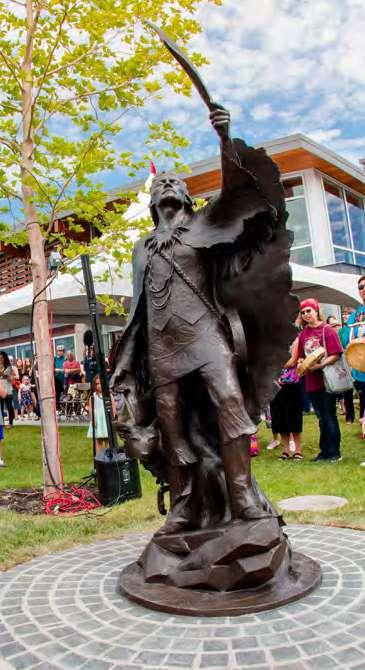
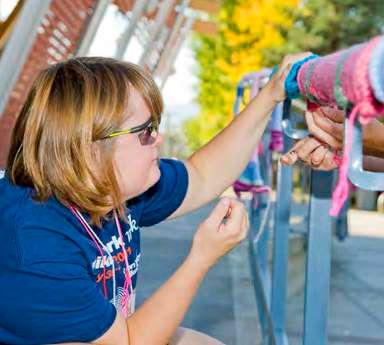



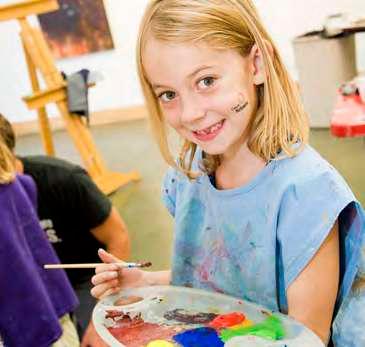






























































































































































































































 Christine McWillis Cultural Services Manager City of Kelowna
Christine McWillis Cultural Services Manager City of Kelowna
























